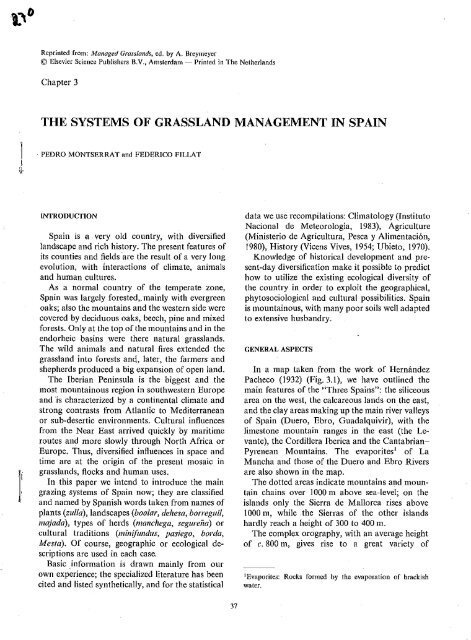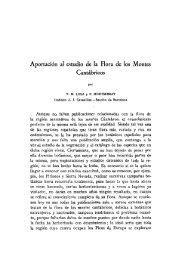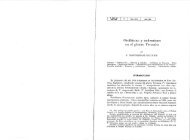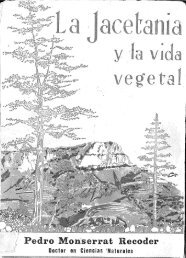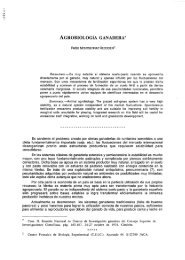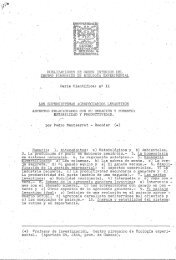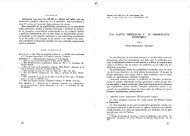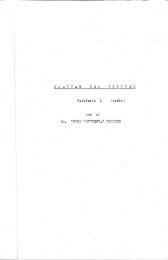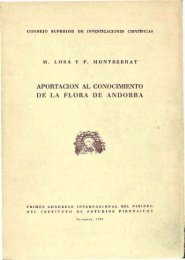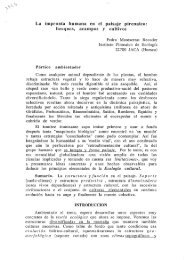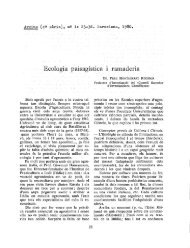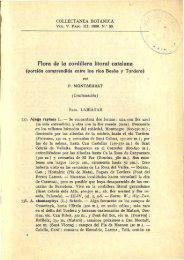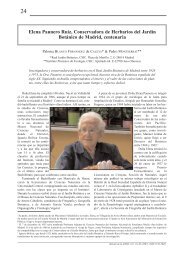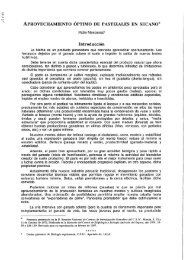the systems of grassland management in spain - Publicaciones del ...
the systems of grassland management in spain - Publicaciones del ...
the systems of grassland management in spain - Publicaciones del ...
Create successful ePaper yourself
Turn your PDF publications into a flip-book with our unique Google optimized e-Paper software.
40day' when <strong>the</strong> areas <strong>of</strong> important <strong>the</strong>rmal <strong>in</strong>versionare localized <strong>in</strong> <strong>the</strong> Duero and Ebro Valleysand <strong>in</strong> La Mancha. In areas c10se to <strong>the</strong> ocean(Galicia and Cantabrian coasts), <strong>the</strong> high atmospherichumidity tempers extreme changes <strong>of</strong>temperatllre, so <strong>the</strong> summers are reasonably coal,favour<strong>in</strong>g <strong>the</strong> growth <strong>of</strong>meadow without necessity<strong>of</strong> irrigation. In thc nor<strong>the</strong>ast, especially aroundGerona, humidity from <strong>the</strong> Mediterranean Seaacts as a thcrmal regulator prevent<strong>in</strong>g extremedesiccation. In <strong>the</strong> south and <strong>the</strong> Balearic Islands,summer droughts are more extreme, due to <strong>the</strong>excessive 1085 <strong>of</strong> llloisture caused by.long hours <strong>of</strong>strong sunsh<strong>in</strong>e heat<strong>in</strong>g <strong>the</strong> soi!. Andalucia isunder a jo<strong>in</strong>t <strong>in</strong>fluence <strong>of</strong> <strong>the</strong> Atlantic and <strong>the</strong>Mediterranean Sea with a maritime climate <strong>in</strong> <strong>the</strong>Strait <strong>of</strong> Gibraltar, cool and wet except at <strong>the</strong>height <strong>of</strong> summer.W<strong>in</strong>d plays an important part <strong>in</strong> mounta<strong>in</strong>areas, such as <strong>the</strong> leeward foehn typical <strong>of</strong><strong>the</strong> greatmounta<strong>in</strong> ranges. Moist maritime air is drawn upover <strong>the</strong> crest and mists are frequen!. Thedescend<strong>in</strong>g currents <strong>of</strong> air are hot and dry. Wehave endeavoured to show (Fig. 3.2B) those w<strong>in</strong>dsthat are best known and <strong>in</strong>tense <strong>in</strong> action such as<strong>the</strong> aptly-named Tramontana (<strong>the</strong> Mistral <strong>of</strong>Ampurdán) <strong>the</strong> Cierzo and MeS/l'a/ <strong>of</strong> <strong>the</strong> EbroValley and Tarragona, and <strong>the</strong> Abrego, a hot dryw<strong>in</strong>d which blows down from <strong>the</strong> Meseta towards<strong>the</strong> Cantábrico. The Regañon blows from. Galiciatowards <strong>the</strong> Duero Valley.F<strong>in</strong>ally, to give an idea <strong>of</strong> <strong>the</strong> seasonal fluctuations<strong>of</strong> ra<strong>in</strong>fall <strong>in</strong> different parts <strong>of</strong> Spa<strong>in</strong> we havedrawn a map (Fig. 3.3) show<strong>in</strong>g <strong>the</strong> predom<strong>in</strong>ance<strong>of</strong> ra<strong>in</strong>fall <strong>in</strong> any given season. The typical w<strong>in</strong>terra<strong>in</strong>s <strong>of</strong> <strong>the</strong> Atlantic zone do not penetrate very far<strong>in</strong>land due to <strong>the</strong> action <strong>of</strong> <strong>the</strong> Iberian anticyclone;located <strong>in</strong> <strong>the</strong> centre <strong>of</strong><strong>the</strong> Pen<strong>in</strong>sula <strong>in</strong> this season.However, <strong>the</strong>se heavy w<strong>in</strong>ter and autumn ra<strong>in</strong>s doprevail <strong>in</strong> some valleys, Iike that <strong>of</strong> <strong>the</strong> Guadalquivirand especial1y <strong>the</strong> Tajo.Mov<strong>in</strong>g <strong>in</strong>land from <strong>the</strong> Atlantic-CantabrianRegion and because <strong>of</strong> <strong>the</strong> altitude it can be seenthat <strong>the</strong> maximum amount <strong>of</strong> ra<strong>in</strong> falls <strong>in</strong> w<strong>in</strong>terand spr<strong>in</strong>g ("w<strong>in</strong>ter-spr<strong>in</strong>g-autumn-summer" on<strong>the</strong> map). In <strong>the</strong> east, <strong>the</strong> ra<strong>in</strong>s are characterized byMediterranerlO <strong>in</strong>fiucnce and <strong>the</strong> autumn is <strong>the</strong>typical season (Balearic Islands, Valencia); <strong>in</strong> <strong>the</strong>Ebro Valley <strong>the</strong> spr<strong>in</strong>g ra<strong>in</strong>s are more important("autumn-spr<strong>in</strong>g-w<strong>in</strong>ter-summer" on <strong>the</strong> map).PEDRO MONTSERRAT and FEDERICO FILLATThe dotted areas on <strong>the</strong> map <strong>in</strong>dicate <strong>the</strong> c10sed<strong>in</strong>terior valleys <strong>of</strong> <strong>the</strong> Pen<strong>in</strong>sula where Iittle ra<strong>in</strong>falls, and it is irregularly dispersed tend<strong>in</strong>g to fall <strong>in</strong><strong>the</strong> hotter months as a result <strong>of</strong> convectionalstorms. In <strong>the</strong>se valleys <strong>the</strong>re is a predom<strong>in</strong>ance <strong>of</strong>spr<strong>in</strong>g ra<strong>in</strong>s ("spr<strong>in</strong>'g-autumn-w<strong>in</strong>ter-summer").Only <strong>in</strong> a few places such as <strong>the</strong> bas<strong>in</strong>s <strong>of</strong> <strong>the</strong> Jilocaand Alfambra (Teruel), La Cerdaña, <strong>the</strong> eastemPir<strong>in</strong>éos and Cadí, thcrc are frequent summerstorms and this season is <strong>the</strong> ra<strong>in</strong>iest ("summerspr<strong>in</strong>g-autumn-w<strong>in</strong>ter").The areas which have been left blank are thoscwhel'e c1imate is very changeable, oscillat<strong>in</strong>gbetween <strong>the</strong> types aIready mentioned.Logically, <strong>the</strong> regions with autumn and w<strong>in</strong>terra<strong>in</strong>s are those affected by <strong>the</strong> above-mentionedmaritime air-masses dur<strong>in</strong>g <strong>the</strong> colder months andwhere, <strong>the</strong>refore, <strong>the</strong> humidity is act<strong>in</strong>g as a<strong>the</strong>nnic regulator. The summers are usually dryand, s<strong>in</strong>ce vegetation is scarce, this general characteristic<strong>of</strong> Spa<strong>in</strong> has contributed to <strong>the</strong> traditionalimportance <strong>of</strong> sheep, which must be moved to <strong>the</strong>weUer and cooler mounta<strong>in</strong> areas. The autumnand spr<strong>in</strong>g ra<strong>in</strong>s characteristic <strong>of</strong> <strong>the</strong> Mediterraneanc1imate facilitate <strong>the</strong> growth <strong>of</strong> trees such as<strong>the</strong> evergreen oak and <strong>the</strong> p<strong>in</strong>e, especially P<strong>in</strong>"sha/epensis. As one moves fur<strong>the</strong>r <strong>in</strong>land <strong>the</strong>wea<strong>the</strong>r becomes variable with sudden changes <strong>of</strong>temperature, and <strong>the</strong> vegetation becomes steppelike,dry, with scrubbier graz<strong>in</strong>gs and very roughgrasses.The c1imatological studies <strong>of</strong> Spa<strong>in</strong> are numerousand we select only some papers like: Filia t(1983) for seasonality <strong>of</strong>ra<strong>in</strong>s, and a simplifica tionby leona and González Rebollar (1974). Maps arebased also on those <strong>of</strong> <strong>the</strong> Servicio MeteorológicoNacional (1965, 1972) and <strong>the</strong> Instituto Nacionalde Meteorologia (1983). Regional studies <strong>in</strong>cludethose on Galicia by Diaz Fierros (1971); onCataluña, by Febrer(l930); on Aragón by Lisoand Ascaso (1969); and central Spa<strong>in</strong> by SánchezEgea (1975).1Priday 4 February 1983, m<strong>in</strong><strong>in</strong>lllm temperatures. Highpressure centre <strong>of</strong> 1043 robar <strong>in</strong> 43°N, 17°W; anticyclol1c curveson thc Iberian Pen<strong>in</strong>sula.
THE SYSTEMS üF GRASSLAND MANAGEMENT IN SPAIN 41FRANCE~~~~~~nrr.Fig. 3.3. Seasonal distribulion <strong>of</strong> precipitalion. Thc scasons are ordcrcd froro <strong>the</strong> railliest to Ihe driesLaYER 1000 MWINTER-AUTUMN-SPRING-SUMMERWINTER-SPRING-AUTUMN-SUMMERAUTUMN-WINTER-SPRING-SUMMERAUTUMN-SPRING-WINTER-SUMMERSPRING-AUTUMN-WINTER-SUMMERSUMMER-SPRING-AUTUMN-WINTERDynamies <strong>of</strong> vegelalion related to soH andtopographyThere is a tendeney <strong>of</strong> plant eommunities lochange until lhe oplimum vegetation for lhe soilconditions establishes itself, Ihat is unlil a climax isreaehed. Where <strong>the</strong>re is a genller lopography anderosion is mínimal, a balance can be reached fOIgiven climatic conditions, if this is not prevented bylhe aclion <strong>of</strong> animals or mano Exploitation byanímals togc<strong>the</strong>r with acute erosion on mounta<strong>in</strong>slopes results <strong>in</strong> a simplifieation <strong>of</strong> local planlcommllnities, until autogenic succession balances<strong>the</strong> losses. Every permanent cornmunity is anexpression <strong>of</strong> this balance.The formation <strong>of</strong> <strong>the</strong> soil layer is slow and Ihenatural plant commllnities tend to preserve it.Compact shoots, 8tolon8 and rhizomes, <strong>in</strong>tcrwcav<strong>in</strong>g<strong>of</strong> roots al <strong>the</strong> surface and deeper down,prevent Ihe soil be<strong>in</strong>g carried away and contribulelo <strong>the</strong> formation <strong>of</strong> a glacis. Herbs eover<strong>in</strong>g a soilwhich is basically unslable provide a dynamic andefficient protection.The ma<strong>in</strong> topographieal features <strong>of</strong> lhe Pen<strong>in</strong>sula(Fig. 3.4A)The Pyrenees were formed by a very fragmenled
42 PEDRO MONTSERRAT and FEDERICO FILLATbaAtlanticOceanaCordilleraIbérica~+-~--r +"Macizo Hespérico"PyreneesEbro ~Valle~.\'bW Spa<strong>in</strong>"Alcarria""Síerras"E Spa<strong>in</strong>e+ +d(A)PastureCrest ~-='r:-:¡=Fores tHeadowsRiverCulture(E)Glacis:. 1 •••• 6" • " •Fluvial terracesPig. 3.4. A. The ma<strong>in</strong> lopographical [catmes <strong>of</strong> Lhe Pen<strong>in</strong>sula. a-b is a cross-section from Portugal to <strong>the</strong> Pyrenees, c-d is a crosssectionfmm Ihe Meseta lo lhe Mediterranean Sea; lhe gcomorphological names <strong>in</strong> Spanish are puL on lhe draw<strong>in</strong>g. n. Typical slopewilh lopographical sequences.
THE SYSTEMS OF GRASSLAND MANAGEMENT IN SPAIN43ancient socIe l and its recent üligocene orogeny isvery rich <strong>in</strong> lime and flysch.The great "Macizo Hespérico"2 <strong>of</strong> CaledonianHercynian orogeny presents an overall homogeneityexcept at <strong>the</strong> extreme edges where MesoCenozoic mounta<strong>in</strong>s are found (Montes Cantábricos,Montes Ibéricos, Sierras Béticas). It is a horstlimited by a system <strong>of</strong> faults to <strong>the</strong> nor<strong>the</strong>ast (<strong>the</strong>Ebro Bas<strong>in</strong>) and south (<strong>the</strong> Guadalquivir Bas<strong>in</strong>).Duúng <strong>the</strong> Miocene, <strong>the</strong> Pliocene and at <strong>the</strong>present time, evaporites have been laid down <strong>in</strong> <strong>the</strong>Ebro Valley (dry with strong W-NW w<strong>in</strong>ds), <strong>in</strong>Castilla and La Mancha. The endorheic bas<strong>in</strong>swere <strong>of</strong> less importance <strong>in</strong> <strong>the</strong> Guadalquivir Bas<strong>in</strong>but <strong>the</strong>y are still to be found <strong>in</strong> <strong>the</strong> great mounta<strong>in</strong>ranges <strong>of</strong> <strong>the</strong> sou<strong>the</strong>as!. The tilt<strong>in</strong>g <strong>of</strong> <strong>the</strong> Meseta,comb<strong>in</strong>ed with partial subsidence on <strong>the</strong> Atlanticside (Rías gallegas), dra<strong>in</strong>ed Castilla and LaMancha, reduc<strong>in</strong>g endorheism but re-activat<strong>in</strong>gerosion along <strong>the</strong> Iberian edge, with <strong>the</strong> consequentrenewal <strong>of</strong> soHs and <strong>the</strong> expansion <strong>of</strong>gypsophilic communities.TopographieaI mieroelimatesOn mounta<strong>in</strong> slopes microclimate varies accord<strong>in</strong>gto <strong>the</strong> degree <strong>of</strong> exposure to sunsh<strong>in</strong>e and <strong>the</strong>type <strong>of</strong> prevail<strong>in</strong>g w<strong>in</strong>ds. They can be ascend<strong>in</strong>gw<strong>in</strong>ds, with <strong>the</strong> formation <strong>of</strong> mist or descend<strong>in</strong>gfoehn w<strong>in</strong>ds. When <strong>the</strong>re is a channell<strong>in</strong>g <strong>of</strong> w<strong>in</strong>d(Venturi elfect) it causes drought <strong>in</strong> certa<strong>in</strong>localized spots (this is <strong>of</strong>ten caused by descend<strong>in</strong>gw<strong>in</strong>ds). Each type <strong>of</strong> microclimate favours adilferent k<strong>in</strong>d <strong>of</strong> plant growth, and as a result <strong>the</strong>flora <strong>of</strong> <strong>the</strong> Iberian Pen<strong>in</strong>sula is very rich. Beeause<strong>of</strong> <strong>the</strong> mounta<strong>in</strong>-valley sequenees already mentioned,drought conditions can be found even <strong>in</strong>environments with a wet oceanic type <strong>of</strong> c1imatc.This is a source <strong>of</strong> diversity, with prcservation afvery particular plants, and also eaus<strong>in</strong>g greatspeeialization <strong>in</strong> pasture <strong>management</strong> (see alsoMontserrat, 1980, 1981, 1983).Thc dynamies <strong>of</strong> waterAs mentioned aboye, <strong>the</strong> prcsence <strong>of</strong> water¡nfluenees temperature due to its high specifie andlatent hea!. Water also causes erosion throughfreez<strong>in</strong>g-thaw<strong>in</strong>g, imbib<strong>in</strong>g-dry<strong>in</strong>g out· and runolf.On <strong>the</strong> o<strong>the</strong>r hand, <strong>in</strong> its role as transportagent, it eontributes to fertilization and facilita tesplant reeuperation. The topography, frequency <strong>of</strong>mists, water-vapour condensation under ground,etc., all <strong>in</strong>Ouence <strong>the</strong> dynamism <strong>of</strong> pasture-Iands,as do both erosion and rapid soi] reeovery.Erosion is a process which liberates soil-enrich<strong>in</strong>gnutrients, <strong>the</strong> loss <strong>of</strong> which is prevented by soilbacteúa aud <strong>the</strong> iutense root activity <strong>of</strong> certa<strong>in</strong>plants. This activity is greatest <strong>in</strong> luxuriant arcasbordeúng forest, <strong>in</strong> meadows, and espeeially where<strong>the</strong>re is a productive <strong>grassland</strong>. Watercourses havebeen changed to irrigate pasture-Iand, fodder eropsare grown where <strong>the</strong>y are appropriate to <strong>the</strong>surround<strong>in</strong>g environment, with an eye to choos<strong>in</strong>gspecies that resist unpredictable periods <strong>of</strong> dryness,and <strong>the</strong> herds are moved to places where <strong>the</strong>topographical microclimate is optimal. Plants,animals and human activities are a refiexion <strong>of</strong>climate,Watercourses and associated phenomena(Fig. 3.4B)Topographieal sequences on slopes are l<strong>in</strong>kedma<strong>in</strong>ly to geophysical characteústics like rockhardness, 01' to protection <strong>of</strong> <strong>the</strong> soil by plantsaga<strong>in</strong>st erosiono Deeper soils are found ma<strong>in</strong>ly onfluvial terraees and glacis, but also on slopes,cl/estas, protected by hard rocks (polycyc1ic relief)as <strong>in</strong> our scheme, obviously favour<strong>in</strong>g accumulation<strong>of</strong> soil, and <strong>the</strong> establishment <strong>of</strong> grasses andtrees, and caus<strong>in</strong>g great diversity <strong>in</strong> a restrictedspace.The rclationship between <strong>the</strong> animals and environmentis reciprocal; fOI example, mounta<strong>in</strong>tops are fertilized by animals <strong>in</strong> <strong>the</strong>ir search forcool w<strong>in</strong>dy areas where <strong>the</strong>y will not be plagued byflies. Although high mOllnta<strong>in</strong> erests are <strong>of</strong>tenlInproductive and stony, <strong>the</strong>y are never<strong>the</strong>less asouree <strong>of</strong> <strong>the</strong> water needed for lower mounta<strong>in</strong>pastnres.The deve!opment <strong>of</strong> <strong>the</strong> vegetation, transhumanee<strong>of</strong> animals and human activities have beenshaped by <strong>the</strong> variation <strong>of</strong> <strong>the</strong>se environments,form<strong>in</strong>g repetitive patterns which can be studied.S<strong>in</strong>ce snch diversity exists <strong>in</strong> Spanish valleys itmight be helpful to study some examples which willenable us to nnderstand <strong>the</strong> general trends <strong>of</strong>lThc Axial Pyrenecs formed dur<strong>in</strong>g Hercynian orogeny.2The olclest part <strong>of</strong> <strong>the</strong> Ibccian Pen<strong>in</strong>sula.
44animal husbandry <strong>in</strong> <strong>the</strong> past and also its futurepossibilities.Soil evolution <strong>in</strong> different habitatsIt seems necessary to consider not only <strong>the</strong>climatic and topographical frames with<strong>in</strong> whichsoil develops but also <strong>the</strong> type <strong>of</strong> rock which forms<strong>the</strong> parent materia!.In siliceous zones <strong>of</strong> Spa<strong>in</strong>, and also <strong>in</strong> a part <strong>of</strong>Portugal, <strong>the</strong> so-calIed "Escudo Hespérico" withPalaeozoic mounta<strong>in</strong>s is formed ma<strong>in</strong>ly <strong>of</strong>siliceousrocks (Galicia, Montes de León, Sierras de Gredosand Guadarrama, Oretana 01' Montes de Toledo,and Sierra Morena), and this is most evident on <strong>the</strong>Cambrian slates 01' <strong>in</strong> <strong>the</strong> granitic regions. Mounta<strong>in</strong>crests where quartz is present <strong>in</strong> quantity haveresisted erosion, but <strong>the</strong> soil is very pOOl". TheSpanish oak (QlIerclIs pyrenaica) <strong>in</strong> <strong>the</strong>se areaseffectively mobilizes and retaios m<strong>in</strong>eral cationswhich would o<strong>the</strong>rwise be lost to <strong>the</strong> pastureland,and thus helps to form <strong>the</strong> grazed bardal, a verytypical k<strong>in</strong>d <strong>of</strong> Spanish westem <strong>grassland</strong>s.Hard limestone rocks, which form cliffs andstony mounta<strong>in</strong> crests, provide a suitable base for<strong>the</strong> deep-rooted legumes so sought by sheep.Mixed woods evolve at <strong>the</strong> base <strong>of</strong> <strong>the</strong>se cliffs.They are rich <strong>in</strong> a variety <strong>of</strong> species and readilylend <strong>the</strong>mselves to pastoral exploitation. Thefrequency <strong>of</strong> alternat<strong>in</strong>g areas <strong>of</strong> marl, sandstoneand conglomerates favours diversity <strong>of</strong> soH typesand <strong>the</strong> different k<strong>in</strong>d <strong>of</strong> pastures which may befound <strong>in</strong> valleys dedicated to graz<strong>in</strong>g.F<strong>in</strong>ally, <strong>the</strong> geological deposition <strong>of</strong> evaporites<strong>in</strong> <strong>the</strong> wide valleys <strong>of</strong> Aragón, La Rioja and LaMancha has helped to preserve a very speeializedfiora, adapted to <strong>the</strong> presence <strong>of</strong> both gypsum andsalt. The large quantity <strong>of</strong> gypsum prevents <strong>the</strong>formation <strong>of</strong> black alkali (sodium carbonate),which has had such a devastat<strong>in</strong>g effect on similarenvironments <strong>in</strong> o<strong>the</strong>r countries.Diversiflcation <strong>of</strong> pasture-landTak<strong>in</strong>g a broad view <strong>of</strong> <strong>the</strong> dynamics <strong>of</strong> (henatural vegetation and its development, especiallythat which has been subjected to erosion, recoveryand diversificatiol1, <strong>the</strong> extreme importance <strong>of</strong>suchdiversification can readily be understood.By observ<strong>in</strong>g <strong>the</strong> behaviour <strong>of</strong> gregarious animalsman leamt how best to make use <strong>of</strong> <strong>the</strong>sediversities. Gregarious ethology, and knowledge <strong>of</strong>PEDRO MONTSERRAT and FEDERICO FtLLAT<strong>the</strong> traditional methods <strong>of</strong> <strong>the</strong> past, both contributedto <strong>the</strong> development <strong>of</strong> graz<strong>in</strong>g land and alsoto <strong>the</strong> <strong>in</strong>tegration <strong>of</strong> <strong>the</strong> farmer with his surround¡ngs. For this reason it is necessary to describe <strong>the</strong><strong>in</strong>terplay between <strong>the</strong> animals and <strong>the</strong>ir habita t,whe<strong>the</strong>r <strong>in</strong> terms <strong>of</strong>plants and animals found <strong>the</strong>re01' geophysical conditions. Any given breed is <strong>the</strong>consequence <strong>of</strong> ¡ts evolution <strong>in</strong> a specific envirOllment.The group adapts by a process <strong>of</strong> selectionand <strong>the</strong> result<strong>in</strong>g genetical evolution. This means,with<strong>in</strong> any given mounta<strong>in</strong> habitat, that it ispossible to preserve those breeds that are not onlywell adapted but can be ma<strong>in</strong>ta<strong>in</strong>ed at a m<strong>in</strong>imumcostoAn historieal perspeetive <strong>of</strong> animal husbandry <strong>in</strong>Spa<strong>in</strong> (Fig. 3.5)The shepherd <strong>of</strong> <strong>the</strong> Neolithic revolution(Moore, 1981) leamt fram <strong>the</strong> wild fiocks. Nomadismand also fiock movements <strong>in</strong> <strong>the</strong> mom<strong>in</strong>g,rest<strong>in</strong>g at noon and sheepfold<strong>in</strong>g, have evolvedfrom <strong>the</strong> behaviour <strong>of</strong> wild animals. Similarly,gregariousness and graup life pass directly framanimals to menoWe present by maps (Fig. 3.5) <strong>the</strong> cultural<strong>in</strong>ftuences <strong>in</strong> Spa<strong>in</strong> from Neolithic times to <strong>the</strong>Middle Ages. Megalithism and "Campaniforme"culture carne fram Egypt to <strong>the</strong> Balearic Islandsand sou<strong>the</strong>m Spa<strong>in</strong>. In Fig. 3.5A we show a range<strong>of</strong> <strong>the</strong>se <strong>in</strong>fiuences fram 4000 years ago. Megalith¡sro was very rare <strong>in</strong> central Spa<strong>in</strong>.From 2000 RC until <strong>the</strong> beg<strong>in</strong>n<strong>in</strong>g <strong>of</strong>Roman<strong>in</strong>ftuence (200 B.C.) <strong>the</strong>re was a cont<strong>in</strong>uous fiow <strong>of</strong><strong>in</strong>ftuences from <strong>the</strong> Near East (Phoenicians,Greeks) to eastem and sou<strong>the</strong>m Spa<strong>in</strong> (Fig. 3.5B)and also fram <strong>the</strong> northwest <strong>of</strong> Africa (Argarculture). Before <strong>the</strong> Romans carne to Spa<strong>in</strong>(900-650 RC.), <strong>the</strong> Celts <strong>in</strong>fiuenced Spa<strong>in</strong>, ma<strong>in</strong>ly<strong>in</strong> <strong>the</strong> northwest. In our map we outl<strong>in</strong>e approximately<strong>the</strong> zones <strong>of</strong> <strong>in</strong>fiuence and <strong>the</strong>ir limits.Romanization was ¡ntense <strong>in</strong> eastern Spa<strong>in</strong> andAndalucía (Fig. 3.5C), develop<strong>in</strong>g <strong>the</strong> agricnlturaltechniques founded <strong>in</strong> <strong>the</strong> villa organization <strong>of</strong> <strong>the</strong>conntry (this is found typicalIy <strong>in</strong> <strong>the</strong> mas <strong>of</strong> <strong>the</strong>nor<strong>the</strong>ast and <strong>the</strong> cortijo <strong>in</strong> sou<strong>the</strong>m Spa<strong>in</strong>).Roman penetration to <strong>the</strong> west <strong>of</strong> <strong>the</strong> Pen<strong>in</strong>sula(Evora and Mérida) was slow and only veryscattered, limited to m<strong>in</strong>es or <strong>the</strong>rmal waters <strong>in</strong>central Ol' nol'<strong>the</strong>rn Spa<strong>in</strong>. W<strong>in</strong>e and cereals wcrc
A - SHEEP,. .---'=,"B- SWINE...,:t"''"~~'--=;~~'" ọ"DONKEYS-o~"'?J~ 1> []]TXISQUETtU 3-IBERICA EaZi0JALADA0"0~ nDNKEYS~ ANDALUZ ~ANDALUZPONY GALAICD- " " ZAMDRJ\.-~ ASTUR m::::B NO-LEONESITlIIIlJl PON'! VASCO-NAVARRO[gMONTEsn~Q:L2] RASA mSEGUREf:I~ RIPDLLESA BGUIRRA4-ENTREFINA mJ CASTELLANA~ ALCARRE~A~ l1I\NCHEGACIDVICH"""'#~W~/dZo¡,:>-~¡,:"' ~Z~ZFig. 3.6. Geographical distribution <strong>of</strong> farm animals. A. Breeds <strong>of</strong> sheep (from Sánchez Belda and Sanchez Trujillano. 1979). B. Sw<strong>in</strong>e breeds (from de Juana and Zuzuarregui,1966). C. Horses and donkeys (from Saraza Ortiz et aL 1975). D. Cattle (from Sánchez Belda. 1976 and Saraza. 1975).:':;
48Information on <strong>the</strong> distribution <strong>of</strong> traditionalherds <strong>in</strong> Spa<strong>in</strong> can be found <strong>in</strong> general books, for<strong>in</strong>stance, Sarazá et al. (1975) 01' <strong>in</strong> regionalmonographs: Rodríguez (1955); Echevarria Belzunegui(1975); Francia (1978); de Miguel (1978);Sánchez (1978).THE MAIN GRAZING SYSTEMS IN SPAIN AT THEPRESENT TIMEInlroduelionThe maps <strong>in</strong> Fig.3.7 summarize <strong>the</strong> uses <strong>of</strong>agricultural and forested land. They are based on<strong>the</strong> most recent statistics supplied by <strong>the</strong> M<strong>in</strong>isteriode Agricultura (1980). Our ma<strong>in</strong> aim has been toshow, quantitatively, <strong>the</strong> relationship <strong>of</strong> differentprov<strong>in</strong>ces to ane ano<strong>the</strong>r.The relative importance <strong>of</strong> different types <strong>of</strong>land usage is summarized <strong>in</strong> <strong>the</strong> central diagram,that is, agricultural, forested, meadow and pasturelandand o<strong>the</strong>r miscellaneous uses. More than 70%<strong>of</strong> <strong>the</strong> land is taken up by cultivation and forestry.The great pla<strong>in</strong>s <strong>of</strong> <strong>the</strong> Duero, <strong>the</strong> Tajo, LaMancha, La Campiña <strong>in</strong> Andalucía and a big part<strong>of</strong> <strong>the</strong> sou<strong>the</strong>ast (Murcia-Alicante) have beenploughed for centuries. Permanent <strong>grassland</strong>s arefound <strong>in</strong> <strong>the</strong> nor<strong>the</strong>rn region 01" <strong>in</strong> mounta<strong>in</strong>s, andalso <strong>in</strong> lhe lVestern region (Salamanca-Extremaduraand western Andalucía) IVhere <strong>the</strong> dehesaorganization <strong>of</strong> pasture-Iand is typical. Extensivereforestation has taken place <strong>in</strong> Galicia, <strong>the</strong>Basque country, and <strong>the</strong> prov<strong>in</strong>ces <strong>of</strong> Barcelona,Gerona and Huelva.Figure 3.8 sholVs fur<strong>the</strong>r details <strong>of</strong> land use withspecia! reference to graz<strong>in</strong>g land. In <strong>the</strong> north andlVest <strong>the</strong> distribution <strong>of</strong> <strong>grassland</strong> is dependent onhumidity and edaphic factors and it is generallyprivately owned, while <strong>the</strong> rough pastures arecommunal. In areas such as <strong>the</strong> dehesa (a type <strong>of</strong>natural evergreen oak [orest, managed underextensive farm<strong>in</strong>g), <strong>the</strong> timber production is unimportan!.Lastly (Fig. 3.80) <strong>the</strong>re is <strong>the</strong> sou<strong>the</strong>asternregion with "Esparto" (Stipa tenacissima)rough <strong>grassland</strong>.To complete <strong>the</strong> picture, lVe have also shown(Fig.3.9) <strong>the</strong> areas IVhere trees are cuitivated for<strong>the</strong>ir fruit (olives, almonds, etc.) and <strong>the</strong> dehesarcgion.PEDRO MONTSERRAT "nd FEDERICO FlLLATSorne types <strong>of</strong> graz<strong>in</strong>g syslemsFigure 3.10 sholVs sixteen different types <strong>of</strong>pasture-Iand found <strong>in</strong> Spa<strong>in</strong> and <strong>the</strong> ma<strong>in</strong> routes <strong>of</strong>transhumance traditionally followed by flocks toreach areas <strong>of</strong> w<strong>in</strong>ter graz<strong>in</strong>g.European-Atlanlic sectorCanlabrian meadows. General characlerislics(Montes Cantábricos and Galicia Regions, No. la,lb and Ic <strong>in</strong> Fig. 3.\0). In a wet climate it is easy toma<strong>in</strong>ta<strong>in</strong> <strong>the</strong> meadows <strong>in</strong> good condition byperiodic cutt<strong>in</strong>g. Maritime air and also frequentmists provide <strong>the</strong> necessary humidity to pasturessurroundcd by 1V00dland. Grazed lands are found<strong>in</strong> <strong>the</strong> more rocky rugged slopes (brañas <strong>in</strong> <strong>the</strong>Cantabrian Mounta<strong>in</strong>s) and meadows <strong>in</strong> moreaccessible regions for cutt<strong>in</strong>g and stor<strong>in</strong>g (hay orsilage). The grass lVas fonnerly scy<strong>the</strong>d up to aslope <strong>of</strong> 30-40°, although nOlVadays, because most<strong>of</strong> this <strong>grassland</strong> has been abandoned, bracken andna tural woods have replaced meadolVs while <strong>the</strong>lVarmer, lower slopes have been reafforested withp<strong>in</strong>e (P<strong>in</strong>us radiata) or ElIcalyptus.Near <strong>the</strong> more densely populated coastal regions,IVhere <strong>the</strong>re are scattered factories, one f<strong>in</strong>ds<strong>the</strong> so-called prado-jardín or <strong>grassland</strong>s dedicatedto dairy cattIe. This dual activity (<strong>in</strong>dustry andcattle) is typical <strong>of</strong> Cantabria, Asturias andGalicia, with well-managed meadows <strong>in</strong>terspersedwith small allotments. Most <strong>of</strong> <strong>the</strong>se <strong>grassland</strong>s aredom<strong>in</strong>ated by Fes/uca arulld<strong>in</strong>acea, a spontaneousgrass stand<strong>in</strong>g up well to frequent cutt<strong>in</strong>g, andcharacteristic <strong>of</strong> good soils near <strong>the</strong> Cantabriancoast (Sociedad Nestlé, 1980).Fur<strong>the</strong>r <strong>in</strong>land, w<strong>in</strong>ter production decreascstoge<strong>the</strong>r with cutt<strong>in</strong>g frequency. Away from <strong>the</strong>villages <strong>the</strong>re are stabIes near <strong>the</strong> cut grass and <strong>the</strong>production is stored as hay for feed<strong>in</strong>g to stock <strong>in</strong>\Vio ter; generally, pastures are more importantthan <strong>in</strong> <strong>the</strong> coastal region. There are plantcommunities <strong>of</strong> Arrhenalflefion e1a¡;oris or Cynosurion(Tiixen and Oberdorfer, 1958) and Nardetalio<strong>in</strong> <strong>the</strong> wetter depressions. The practice <strong>of</strong> burn<strong>in</strong>gw<strong>in</strong>ter <strong>grassland</strong> has given rise to communities <strong>of</strong>heathlands (ma<strong>in</strong>ly Ulex europeus or U. gallii).Erica l'agan~ abounds <strong>in</strong> dry limestone mounta<strong>in</strong>regions, as aga<strong>in</strong>st E. c<strong>in</strong>erea and Calfuna vulgaris\Vhere <strong>the</strong> substrate is siliceous. The big Edca
1iI§¡¡IlI>60~ 50-60§ 30-50[[[]] 20- 300
lA GRASSLAND(%)1W1! >75~50-75825-50ITOJ15-25c::=l < 15FORESTED, NO!e PRODUCUilG TIMBER(% o f total forested)!ii28l > 75EZ!!J 50-758 25- 50rrm ///~/~i/(;;75~ 50-75Pig. 3.8. Usage <strong>of</strong>land. Sorne subdivisions. A and B are two subclasses <strong>of</strong>Fig. 3.7C. e The "over 75%" category represents <strong>the</strong> dehesa zone; <strong>the</strong> figures are for <strong>the</strong> proportion <strong>of</strong>forest land (Fig. 3.7B) Dot produc<strong>in</strong>g timber. D. Grazed agriculturalland; <strong>the</strong> Erial a pastos class is typical <strong>of</strong><strong>the</strong> driest part <strong>of</strong>Spa<strong>in</strong> (% af<strong>the</strong> "O<strong>the</strong>rs" category <strong>in</strong> Fig. 3.7D).IIII I '--l :"-'·.... ···.:....:....-.:;:i.:::~.....J#,0..- ",'!.Ih~,-:I. '"_r_ ~_~ %." "''''o~~¡::~'" ~~•,Po."'" tJ'"~8."~:¡
THE SYSTEMS üF GRASSLAND MANAGEMENT IN SPAIN51&>'"CULTIVATED J,AND (over 50 %)FDRESTED LAND (aver 50 %)GRASSLAND ANDROUGH GRAZINGS (over 15 %)DEHESAZONE[MJ OLIVE-TREESv (over 5 % <strong>of</strong> cultivated land)Fig. 3.9. Usage <strong>of</strong> land <strong>in</strong> Spa<strong>in</strong>. Summary.C-:J OTHERarborea is typical <strong>of</strong> good woodlands with deepsoils, sometimes associated with Gel/ista florida.Bracken (Pteridiwl1 aqllilil/llm) quickly colonizesderelict <strong>grassland</strong>s <strong>in</strong> <strong>the</strong> hills, but occurs only on<strong>the</strong> sou<strong>the</strong>rn slopes <strong>of</strong> <strong>the</strong> highest mounta<strong>in</strong>s;everywhere <strong>the</strong> prevalence <strong>of</strong> bracken is reduced byheavy cattle graz<strong>in</strong>g 01' early cutt<strong>in</strong>g <strong>in</strong> spr<strong>in</strong>g.The Galician m<strong>in</strong>ifllndlls (la <strong>in</strong> Fig. 3.10). Evennowadays <strong>the</strong> poplIlation <strong>of</strong> Galicia is wi<strong>del</strong>ydispersed (<strong>the</strong>re are here 32700 hamlets, a similarnumber to <strong>the</strong> total <strong>of</strong> aH vilIages <strong>in</strong> <strong>the</strong> rest <strong>of</strong>Spa<strong>in</strong>) cover<strong>in</strong>g an area where <strong>the</strong> resources forcultivatiou are few (less than20% <strong>of</strong>total surface).This means that <strong>the</strong> farms are smalI (5.5 haaverage) consist<strong>in</strong>g <strong>of</strong> a great number <strong>of</strong> plots(average 22) at sorne distance one from o<strong>the</strong>r(10-15 km) (Otero Díaz, 1977). Given <strong>the</strong>se cir-cumstances it is not surpnsmg to f<strong>in</strong>d thal <strong>the</strong>Galician farmer is very attached to his smalIhold<strong>in</strong>g,espeeialIy as <strong>the</strong> whole family is usualIy<strong>in</strong>volved <strong>in</strong> its <strong>management</strong>. In spite <strong>of</strong> this, <strong>the</strong>Iand has been abandoned <strong>in</strong> certa<strong>in</strong> mounta<strong>in</strong>regions and is now overgrown with scrub (utexellropells) and hea<strong>the</strong>r (Erica species 01' Cal/l<strong>in</strong>o),which may cover up to 34% <strong>of</strong> <strong>the</strong> nom<strong>in</strong>alIyforested areas.It is thought, historicalIy, that <strong>the</strong> practice <strong>of</strong>splitt<strong>in</strong>g up land <strong>in</strong>to plots orig<strong>in</strong>ated with <strong>the</strong>Suevi (Sánchez, 1978), when Ihey divided up <strong>the</strong>land. Dur<strong>in</strong>g <strong>the</strong> Reconqllista (9th, 10th and Illhcenturies) stock-farm<strong>in</strong>g <strong>in</strong> Galicia was under <strong>the</strong>control <strong>of</strong> <strong>the</strong> feudal lords and <strong>the</strong> monasticorders. The autochthonous eattle breed (/'libiagallega) <strong>in</strong>creased after <strong>the</strong> potato and maize were<strong>in</strong>trodueed from America (afiel' 1541 when Perú
@'""+ ...."4@ o l. European-Atlantic sector~'"... ".-'t-La -The Galician m<strong>in</strong>ifuncluslb -Mou:l.ta<strong>in</strong> <strong>grassland</strong>le -The "pasiego" type2. The pyrenean sector28 -SubcarLtabrian part <strong>of</strong> Burgos-K1.v¿Jn:a2b -Ar
THE SYSTEMS OF GRASSLAND MANAGEMENT IN SPAIN 53was f<strong>in</strong>ally conquered), thus enrich<strong>in</strong>g lhe traditionalrange <strong>of</strong> foodstuffs, such as rye, turnips,l<strong>in</strong>seed, acorns and chestnuts.Al lhe end <strong>of</strong> <strong>the</strong> 18th century, as lhe result <strong>of</strong>Spa<strong>in</strong>'s ties wüh lhe United K<strong>in</strong>gdom and lhegrowth <strong>in</strong> demand from urban centres <strong>of</strong> <strong>in</strong>duslrializedEngland, a new market for lhe exporl <strong>of</strong>meat was crealed. This broughl about <strong>the</strong> specialization<strong>of</strong> <strong>the</strong> rubia gallega as beef cattle, whichlater found a new markel <strong>in</strong> <strong>the</strong> <strong>in</strong>duslrial cenlres<strong>of</strong> Spa<strong>in</strong> (Rodríguez el al., 1979).Generally speak<strong>in</strong>g, Friesian cows are found on<strong>the</strong> richer graz<strong>in</strong>g land <strong>of</strong>lhe Atlantic coastal areaswhile lhe rubia gallega breed has spread fur<strong>the</strong>r<strong>in</strong>land. Two importanl varieties <strong>of</strong> this breed havegradually evolved, lhe dairy cattle <strong>of</strong> lhe valleysand lhe mounla<strong>in</strong> beef-cattle. Nowadays, <strong>in</strong> spite<strong>of</strong> lhe small scale <strong>of</strong> farm<strong>in</strong>g <strong>in</strong> Galicia (96% <strong>of</strong>farms support less than 6 cows) and difficultieswüh feed<strong>in</strong>g because <strong>of</strong> <strong>the</strong> <strong>in</strong>tricate syslem <strong>of</strong> verysmall plots, Galicia produces someth<strong>in</strong>g more lhan23% <strong>of</strong> <strong>the</strong> calves raised <strong>in</strong> Spa<strong>in</strong>. These are laterfattened <strong>in</strong> arcas situated closer lo lhe ma<strong>in</strong>market<strong>in</strong>g cenlres.Mounta<strong>in</strong> <strong>grassland</strong> (1 b <strong>in</strong> Fig. 3.10). The CantabrianMounta<strong>in</strong>s act as a filter for <strong>the</strong> moisl sea airwith frequent mists on lhe norlh-fac<strong>in</strong>g slopes andto lhe northwest. On lhe leeward side, <strong>the</strong>comb<strong>in</strong>ation <strong>of</strong> drier descend<strong>in</strong>g currents <strong>of</strong> airand a sou<strong>the</strong>rly orientation is associated wilh achange <strong>in</strong> <strong>the</strong> lype <strong>of</strong> pastures and woodland foundlhere. Meadow-Iands are restricted here lo <strong>the</strong>deeper soils <strong>in</strong> <strong>the</strong> valley bottoms or irrigatedgentle slopes. Look<strong>in</strong>g at <strong>the</strong> map one canappreciale lhe imporlance <strong>of</strong> lhese mounta<strong>in</strong>s and<strong>the</strong>ir role as a screen aga<strong>in</strong>st moisture-carry<strong>in</strong>gw<strong>in</strong>ds.The walershed is complicated especially round<strong>the</strong> Picos de Europa which form a gianl barrier. Inlhe sou<strong>the</strong>rn part <strong>of</strong> <strong>the</strong> mounta<strong>in</strong>s <strong>the</strong> drylimeslone supports good pastures which, loge<strong>the</strong>rwilh eroded slopes on slate rock mak<strong>in</strong>g plough<strong>in</strong>gdifficult, have facilitated <strong>the</strong> development <strong>of</strong> <strong>the</strong>nomadic movements <strong>of</strong> sheep flocks (trashumancia).The basic major routes are shown <strong>in</strong> Fig. 3.10;<strong>the</strong>y are called lhe "Zamorano-leonesa" and <strong>the</strong>"Segoviana" ane.Figure 3.11 shows a lransection from Cabuér-Cantabrian Sea/.//////®./././>O" m150() "~1.~: o.,A/,/ ,",,,, , , , , ," , ,"................ ----....BihcenaB©¡ ~ "INVERNALf,S""- ''''VILLI,GEFig. 3.11. MOUlllaill <strong>grassland</strong>s <strong>in</strong> Cantabda prov<strong>in</strong>ce (from Montserrat and Fillat, 1978).'"~"WN'SUl'NER PASIURE~
54niga (Valle de Cabuérniga), on <strong>the</strong> norlh side <strong>of</strong> <strong>the</strong>Cantabrian Mounta<strong>in</strong>s, to <strong>the</strong> river Ebro nearRe<strong>in</strong>osa (Bárcena). This is lypical <strong>of</strong> many mounla<strong>in</strong>s<strong>of</strong> nor<strong>the</strong>rn Spa<strong>in</strong>, with humid cloudy slopeschang<strong>in</strong>g to lhe sunny climale <strong>of</strong> lhe Ebro Valley.The gentle slopes nol very far from <strong>the</strong> MarCantábrico are cultivaled, and very good meadowsare dom<strong>in</strong>anl, grazed or heavily cul near lhehouses. Hedges are common with relics <strong>of</strong> climaxoak (Quereus roblll'J and ash (Frax<strong>in</strong>us exeelsior).The doudy slopes (ascend<strong>in</strong>g maritime w<strong>in</strong>ds)have dense forests <strong>of</strong> beech (Fagus sy/vatiea),meadows, grazed pastures, and bracken (Pter¡diul1laquifil1um) <strong>in</strong> sorne cases. The cross-section e is amore detailed representation <strong>of</strong> lhis part.As one moves lowards <strong>the</strong> 1000 m conlourgraz<strong>in</strong>g becomes more <strong>in</strong>tensive and beech disappears,givillg way lo holly (l/ex aquifoliul1l),hawthorns (erataegus l1lonogyna) and gorse (UlexgalliO with healh (Edea vagans). This is lhe Montetojo, lhe home ground <strong>of</strong> very wild cattle, lheTudanea breed. Fires and graz<strong>in</strong>g act<strong>in</strong>g lhroughcenluries have impoverished lhe highest parts <strong>of</strong><strong>the</strong> cornmunal pastures.The maritime w<strong>in</strong>ds, with frequent ra<strong>in</strong>, passacross lhe mOllnla<strong>in</strong>s and drop down towards lheriver Ebro, so lhal f<strong>in</strong>e wea<strong>the</strong>r is dom<strong>in</strong>anlthrollghoUl lhe year <strong>in</strong> this part. The dry air wilhsunny soulh-fac<strong>in</strong>g slopes, means dry-pasturedom<strong>in</strong>antes loge<strong>the</strong>r wilh lhe characleristic piorna/es(Genista oblusiramea and Cytisus pllJ'gans), a"retamoid" type <strong>of</strong>shmbs very lypical <strong>of</strong> Spa<strong>in</strong>. In<strong>the</strong> upper Ebro Valley very deep soils are found <strong>in</strong><strong>the</strong> bottom <strong>of</strong> <strong>the</strong> glacis on gentle slopes; only near<strong>the</strong> top part is lhe piorna/ dom<strong>in</strong>anl, loge<strong>the</strong>r withhard grasses like Festuea <strong>in</strong>digesta and Agrostis<strong>del</strong>icatu/a. Shrubs like Eriea G/'borea and Genistaflorida are found <strong>in</strong> hedges on <strong>the</strong> besl soils, bulnear lhe villages ashes and oaks also help lo crealea very lypicallandscape (see Fig. 3.lIB).The climax fores! <strong>of</strong> this region is fonned <strong>of</strong>Querells (Q. pyrenaica, Q.fag<strong>in</strong>ea), and <strong>grassland</strong>sare good because lhc soil is deep and rich <strong>in</strong>limestone; but it is dry <strong>in</strong> summer, and irriga tian i8essential <strong>in</strong> order lo have good meadows. TheTlIdanea breed is well adapted to (hese <strong>grassland</strong>sbut now it i8 necessary to change it8 utilization fromoxen for through<strong>in</strong>g and plough<strong>in</strong>g lo meal productionby eross<strong>in</strong>g (heterosis) with olher breeds (seealso FilIal and Montserrat, 1978; López, 1978).PEDRO MONTSERRAT ,ud FEDERICO FILLATThe Pasiego <strong>in</strong> lhe mounta<strong>in</strong>s <strong>of</strong> Burgos-Canlabria(lc <strong>in</strong> Fig.3.1O and Fig.3.12). While moreextensive graz<strong>in</strong>g <strong>systems</strong> are dom<strong>in</strong>ant <strong>in</strong> <strong>the</strong>west-northwest <strong>of</strong> Re<strong>in</strong>osa, <strong>in</strong>tensive <strong>systems</strong> produc<strong>in</strong>gmilk from grass are found <strong>in</strong> <strong>the</strong> norlheaslcmmounta<strong>in</strong>s. The pasiego people have manyspecial cullural characteristics sludied by de Terán(1947), Madariaga (1970), Tax de Freeman (1970),Ortega Valcarcel (1974, 1975) and Leal (1976).Figure 3.12B is a detailed map show<strong>in</strong>g <strong>the</strong>scattered "habita!" <strong>of</strong> <strong>the</strong> lhree municipalitieswhich make up lhe pasiego region <strong>of</strong> <strong>the</strong> Cantabria.The farm build<strong>in</strong>gs (cabañas) are located <strong>in</strong>places where grass is mosl easily grown. Eaehfamily owns several houses <strong>in</strong> differenl places,liv<strong>in</strong>g firsl <strong>in</strong> one and <strong>the</strong>n ano<strong>the</strong>r depend<strong>in</strong>g onlhe needs <strong>of</strong> <strong>the</strong>ir cattle and lhe condition <strong>of</strong> lhepaslures <strong>in</strong> any given area (<strong>the</strong>se moves can takeplace as <strong>of</strong>ten as once a week). The hay is harvesled<strong>in</strong> summer and lhen stored, toge<strong>the</strong>r with lucernewhich is purchased. The farmer <strong>of</strong> this region hasperfected <strong>the</strong> melhod <strong>of</strong> convert<strong>in</strong>g healhland orareas <strong>of</strong> bracken <strong>in</strong>to meadows. The land to beused as meadow is covered with a certa<strong>in</strong> quantity<strong>of</strong> manure enough lo buffer lhe pH and ensure arapid enrichment <strong>of</strong> <strong>the</strong> soi!. Each year a little moremeadow can lhus be rec1aimed depend<strong>in</strong>g on <strong>the</strong>need <strong>of</strong> lhe cattle owned by each family.In Machorras (a Iittle village <strong>in</strong> <strong>the</strong> north <strong>of</strong>Burgos Prov<strong>in</strong>ce), lhe meadows closed by walls <strong>of</strong>stone and <strong>the</strong>ir concomitant farmhouses arecharacleristic <strong>of</strong> <strong>the</strong> area, whieh exlends from analtitude <strong>of</strong> 800 to 1300~ 1400 m. Here, <strong>the</strong> graz<strong>in</strong>gsare periodically burnl olf, and are dom<strong>in</strong>a ted byUlex gallii and Eriea vagans. The latter are grazedby horses and donkeys, cows and sheep (lheChurro breed). The farmers bum lhe roughpasture <strong>in</strong> February-March while lhe ground isstill frozen and w<strong>in</strong>ds are nol likely to be strong.The orig<strong>in</strong> <strong>of</strong> <strong>the</strong> pasiego system reaehes a long wayback and is historically <strong>in</strong>terest<strong>in</strong>g.Future perspeetives. With<strong>in</strong> a relatively small area<strong>of</strong> lhe greal mounta<strong>in</strong>s and <strong>the</strong> ,associated valleys<strong>the</strong>re is a gamut <strong>of</strong> habitats, dlfferenl vegetalioncommunities, different typcs <strong>of</strong> woods, meadowsand pasture-Iand with lhe accompany<strong>in</strong>g variation<strong>of</strong> animal breeds. Associated with <strong>the</strong> animalswhich have adapled to lheir particular environmenl,human groups have grown up with a
THE SYSTEMS OF GRASSLAND MANAGEMENT IN SPAIN 55SANTANDER(A)\ "PASIEGOS"""\ -.~,. - , \ ."oo', .",I ••• \ I",.. ..'\ Vega de Pas __ .1\:.... '"$~_:~__ ~-'_~~¡; l'(. .I ~ ••,. .\., e.e •" .., e."- . .• e.,\/'-/San ROlJ.uede Riomi era•,,
56However, nowadays <strong>the</strong> autumn graz<strong>in</strong>g <strong>of</strong> acornsby pigs (montanera) has disappeared and <strong>the</strong> lachasheep are graz<strong>in</strong>g all <strong>the</strong> year <strong>in</strong> foresl and serubs,loge<strong>the</strong>r wilh an <strong>in</strong>ereas<strong>in</strong>g number <strong>of</strong> horses. Thepony (jaca navarra) is also typieal <strong>of</strong> lhis landseape.Al lhe present time, <strong>the</strong> more <strong>in</strong>tensified agrieullureis limited to <strong>the</strong> deep vaIley soHs, but <strong>the</strong> fieldsare aIways surrounded by hedges, shrubs and trees,ma<strong>in</strong>ly relicts fram <strong>the</strong> anclent forests. Permanent<strong>grassland</strong>s are dom<strong>in</strong>ant on slopes, situated bolow<strong>the</strong> grazed forests.Pastures with Brachypodium p<strong>in</strong>natum dom<strong>in</strong>anl,togelher with Erica vagans or braeken(Pteridium aquil<strong>in</strong>um) show bad graz<strong>in</strong>g teehniques<strong>in</strong> lhis landseape, promoted by <strong>the</strong> abandonmeut<strong>of</strong>marg<strong>in</strong>allands. Ecological diversity is favour<strong>in</strong>ggraz<strong>in</strong>g husbandry <strong>in</strong> this attractive part <strong>of</strong> Spa<strong>in</strong>.The communal organizalion and o<strong>the</strong>r historieal<strong>in</strong>fluences, toge<strong>the</strong>r with an improved road system,will be helpful <strong>in</strong> improv<strong>in</strong>g a new animalhusbandry.Aragón (2b <strong>in</strong> Fig. 3.10)The boa/m·es. The villages <strong>of</strong> lhe HuescaPyrenees, like many o<strong>the</strong>r agrieultural prov<strong>in</strong>ees <strong>of</strong>Spa<strong>in</strong>, reta<strong>in</strong>ed sorne plots <strong>of</strong> forest from lhecommunal property. Traditionally <strong>the</strong>se plols weregrazed by traetÍon animals (oxen, horses, mulesand donkeys). They are ealled dehesa boyal, boveral01' boalar, mean<strong>in</strong>g a surface reserved fOI oxeo. Thedom<strong>in</strong>ant tree is a local oak or quejigo (manyslra<strong>in</strong>s <strong>of</strong>Q.fag<strong>in</strong>ea) or <strong>in</strong> <strong>the</strong> more Mediterraneanpart lhe evergreen oak (Q. ilex subsp. I"Otundifolia).Until recent times (1940-1960) shrubs were verysparse under <strong>the</strong> trees, and were elim<strong>in</strong>ated byheavy graz<strong>in</strong>g, but s<strong>in</strong>ce <strong>the</strong> use <strong>of</strong> mechanicflltraetors has become frequent, this special <strong>grassland</strong>has evolved towards a natural forest.Every hamlet <strong>in</strong> this part <strong>of</strong> <strong>the</strong> Pyrenees has itsown boalar wilh an area <strong>of</strong> 2 to 10 ha accord<strong>in</strong>g to<strong>the</strong> exigences <strong>of</strong> plough<strong>in</strong>g. Under this very sunnyclimale, good <strong>grassland</strong> can be proteeted by acanopy screen <strong>of</strong> pruned trees. Animal dung andur<strong>in</strong>e ereate good eonditions for grass under heavygraz<strong>in</strong>g pressure. This special sod and very produetivelurf should be used <strong>in</strong> <strong>the</strong> future todiversify <strong>the</strong> <strong>grassland</strong> <strong>in</strong> every mounla<strong>in</strong> village,ma<strong>in</strong>ly because it is aeeessible and well adapted tograzmg.PEDRO MONTSERRAT aud FEDERICO FILLATDevelopmenl <strong>of</strong> meadows from fields <strong>of</strong> sa<strong>in</strong>fo<strong>in</strong>and lucerne. Same characteristics <strong>of</strong> mounta<strong>in</strong>meadows are summarized <strong>in</strong> Fig. 3.13. The graph(Fig.3.13c) expla<strong>in</strong>s two importanl effects onquality <strong>of</strong> meadows. The ord<strong>in</strong>ate axis is a quality<strong>in</strong>dex for <strong>the</strong> firsl eul [DNDF~Digestibility <strong>of</strong> <strong>the</strong>eeIl-wall material (neutro-detergent fibre - Goer<strong>in</strong>gand Van Soesl, 1970-)] and <strong>the</strong> abseissa <strong>the</strong>eutt<strong>in</strong>g date. The oeeanic type <strong>of</strong> climate <strong>of</strong> <strong>the</strong>more westerly sites (Hecho and Siresa) wilh amilder spr<strong>in</strong>g faeilitate an early cut as camparedwith Anciles and Cerler. The hay quality is betterat lower (Hecho, 833 m) than al higher altitude(Siresa, 1050 m), and <strong>the</strong> same is lrue <strong>in</strong> <strong>the</strong>eomparison belween Anciles (1200 m) and Cerler(1500 m) <strong>in</strong> <strong>the</strong> easlern Alto Aragón.Table 3.1 shows <strong>the</strong> location <strong>of</strong> eight sampl<strong>in</strong>gsiles on present-day <strong>grassland</strong>: sorne <strong>of</strong> <strong>the</strong>m arecom<strong>in</strong>g from old fields (2, 3 and 5), o<strong>the</strong>rs fromlucerne fields (1 and 4) and f<strong>in</strong>ally one comesdireetly from a cleared foresl (8). In <strong>the</strong> lasl yearssome fieIds were sown with selecled <strong>grassland</strong> seed(6 and 7). In general, we can see lhe height <strong>of</strong>grasses and <strong>the</strong> stabilization <strong>of</strong> legumes at lowlevels.Table 3.2 summarizes <strong>the</strong> total production(eutt<strong>in</strong>g and graz<strong>in</strong>g) <strong>of</strong> a typieal meadow <strong>of</strong> lhisreglOll.Table 3.1 emphasizes <strong>the</strong> effeet <strong>of</strong> manur<strong>in</strong>g onlhe first cut (June 1977) under diversified eondi'tions <strong>of</strong> mounta<strong>in</strong>s. Lucerne rema<strong>in</strong>s many yearstoge<strong>the</strong>r with new-com<strong>in</strong>g spontaneous species,and ma<strong>in</strong>ta<strong>in</strong>s fertility <strong>in</strong> <strong>the</strong> topsoi!. In <strong>the</strong> sameway, sa<strong>in</strong>fo<strong>in</strong> improved soil ferlilily on dry slopeson limes tone. In order to establish new meadows, itwill be essential to use adapted legumes and grasseslike eoeksfoot (Dactylis glomerata) or o<strong>the</strong>r seleetedseeds, always wilh heavy manur<strong>in</strong>g.Thc borda for hay and animals. In <strong>the</strong> SpanishPyrenees, bordas are not very frequent except <strong>in</strong> <strong>the</strong>cenlral region where <strong>the</strong> big valleys are suitable forimportant hay produetion. Figure 3. 14C shows <strong>the</strong>big dissimilarily between lhe easlern and westernsides <strong>of</strong> <strong>the</strong> Monte Perdido, <strong>in</strong> lhe centre <strong>of</strong> thisseelion. The Aneient Pyrenees (<strong>of</strong> Primary orPalaeozoie age) are more important lo lhe east,while <strong>the</strong> Sierras Interiores (more reeent, <strong>of</strong>Oligocene age) are predom<strong>in</strong>ant <strong>in</strong> lhe west;consequently, <strong>the</strong> big valleys are frequenl <strong>in</strong> <strong>the</strong>east. The altitud<strong>in</strong>al distribution <strong>of</strong> bordas is
THE SYSTEMS üF GRASSLAND MANAGEMENT IN SPAIN 57SmlMER BEGINNINGSU.M1lER F.ND~·MPASTURE~¡ean DE plantbiomass <strong>of</strong>fered:7000 kg [resh ha- 1 CALFGrowth <strong>of</strong>:60-150 kgPLAN! RESIOUES4-50 % oE<strong>of</strong>ferDUNG1000 lloiLshaCADAVERS1-2 % <strong>of</strong>to tal animalsgraz<strong>in</strong>g1950 m®GENERALCHARACTERISTTCSOr PASTURES qN A SLOY~Non disturbed pastureNos.: 1,2,3,4Pasture disturbad bytIJe ,,,ild hoarNos.: 5 319001830178017501720,rav<strong>in</strong>~6 I 7hutI8 ,Floodccl zoneNos. : G 7GEOGRAPHICAL AND ALTITUDINAL INFLUENCESONHEADOWSDNDF (% <strong>of</strong>dry maller)40Zaragoza3530• ~ Hechot Siresa833 m1050 m>1- [ AncílcsCerler1200 ID1500 m2520June30 15July31 20AugustFlg. 3.13. Same characteriSlics <strong>of</strong>Pyrcncan paslurcs and meadows. A. A lypical scasonal sequence ror cows <strong>in</strong> a Pyreneall <strong>grassland</strong>. B.A lopographical sequencc <strong>in</strong> <strong>the</strong> weslern Pyrenees from 1720 lo 1950 m. The diversified production is specified <strong>in</strong> Tablc 3.3. C. Thefigure cxpla<strong>in</strong>s thc productiol1 <strong>of</strong>meadows situatcd <strong>in</strong> (he \Vcstern and Centml Pyrcnccs. Produclion is <strong>in</strong>dicatcd (Tablcs 3.1 and 3.2).
THE SYSTEMS QF GRASSLAND MANAGEMENT IN SPAINrn1I Summer pasturespropertyrn Spr<strong>in</strong>g and autumn p. =land€;; w<strong>in</strong>ter pastures <strong>of</strong> cattle OLand onhireq¡¡¡o W<strong>in</strong>ter pastures <strong>of</strong> sheep- lj~ i/;Od~~ItLZJ VILLAGE\30-40 km1 day®SUMMER Shcep andPASTURES cattie grazeLt months(June-Sept.)"PARDINAS"@ZüNE130-HIO xm10-15 days oE"cranshumance"Sheep andcattie graze2 months(May and Oc t.)CatCle graze6 months(Nov.-Apri 1)59WINTERPASTURESShcep graze6 months(Nov.-April)©l'erdidoVIELLA3000 ID2000 ID1000 IDH AABCAA y T. B F Nkm • Mounta<strong>in</strong> vil1ages3000 roThe westernAlto Arag6n@,,,1Village ~)lI1h 5 900Qtf()"Pard<strong>in</strong>a"'!....,",.!'IdV' '\ñl'Ebro32300ti2000 "Borda"W$-,-150011#Village ~4~ ~600,'~ .". 6 q/B•....(J'lllvEbro".'.,",/~,1B .-Ancl-ent Pyrenees- Secondary "Sierras",The easternAlto Arag6n68
THE SYSTEMS üF GRASSLAND MANAGEMENT IN SPAIN 61TABLE3.3Some characterislics <strong>of</strong> Pyrenean pasluresSites Height <strong>of</strong> Fresh weight Composilioll (% <strong>of</strong> DM) DM(%)plants (cm) g m- 2 grasses legumes Carex spp. o<strong>the</strong>rspanicles foliage1 25 5 100 45 J9 7 9 362 35 5 240 84 15 O I 403 50 12 530 81 8 7 4 294 60 15 780 72 5 O 23 315 50 12 400 81 19 O O 386 30 5 120 2 3 95 O 377 50 10 400 53 4 34 9 368 55 15 1020 60 19 O 21 JIDate <strong>of</strong> sampl<strong>in</strong>g: 5 AlIgusl 1974.adapted to <strong>the</strong> brackish wa ter and soil. Among <strong>the</strong>Chenopodiaceae <strong>the</strong>re are sorne genera preadaptedto <strong>the</strong>se soi! and climate conditions,ma<strong>in</strong>ly species <strong>of</strong> Atriplex and Salsola; Salsolal'ermiculata (sisallo) produces its fruit <strong>in</strong> autumn,and <strong>the</strong> sheep enjoy it. The C. plants (especíallythose with grey and glaucous colour<strong>in</strong>g) areresistant to losses by photorespiration, and arevery promis<strong>in</strong>g for this environment. The productiooaf C/1enopodium and Amaranthus seeds rorirrigated brackish soils should also be <strong>in</strong>vesligated.The nor<strong>the</strong>astern sector <strong>of</strong> Cataluña (2c <strong>in</strong>Fig.3.1O). The humid Mediterranean climate <strong>of</strong>this part <strong>of</strong> Spa<strong>in</strong> favours a farm<strong>in</strong>g dispersed overhills and valleys. Such a dispersion is typical <strong>of</strong>oceanic clima tes and regions under a long polilicalstability from <strong>the</strong> Middle Ages till recent times.Effectively, this sector fonned <strong>the</strong> boundary <strong>of</strong> <strong>the</strong>empire <strong>of</strong> Charlemagne ("Marca Hispanica").The Roman <strong>in</strong>stitulion <strong>of</strong> <strong>in</strong>heritance l<strong>in</strong>ked to<strong>the</strong> farmhouse (family unit) was also a new factorfor stability. So, diversity <strong>of</strong> geophysical conditionsand cont<strong>in</strong>uity <strong>in</strong> <strong>management</strong> allowed a verygood protection aga<strong>in</strong>st historical changes, preserv<strong>in</strong>g<strong>the</strong> more essential structures. In every farroone can f<strong>in</strong>d <strong>the</strong> follow<strong>in</strong>g elements: forested part,permanent <strong>grassland</strong>, Mediterranean cultivation <strong>of</strong>w<strong>in</strong>ter cereals, maize, pota toes and typical forageefops like Tl'ifolium <strong>in</strong>carnatum, T. pratense, tur,..nips, cabbages, Italian ryegrass, lucerne, manyhorticultural plants and <strong>the</strong> poplar (Populus spp.)or plane tree (Platanus hybrida) on fluvial terraces.Nowadays, <strong>in</strong>tensified exploilation is be<strong>in</strong>g directedto <strong>the</strong> famous calves, milk, al' selected fmitproduction.Near <strong>the</strong> Gulf <strong>of</strong> Rosas, on fluvial recent soils,one f<strong>in</strong>ds <strong>the</strong> c/oses, fields fenced by stone walIs 01'hedges. On <strong>the</strong>se fields, border<strong>in</strong>g <strong>the</strong> wellermeadows, is also found <strong>the</strong> Emporda type <strong>of</strong>lucerne. Transhumancc from <strong>the</strong> eastern Pyteneesto this sector (see Fig. 3.10) was very important,and expla<strong>in</strong>s <strong>the</strong> devclopment oC lucerne andsa<strong>in</strong>fo<strong>in</strong> forage.There are books on Pyrenees like Sorre (1943),Solé Sabaris (1951), Viers (1973) and Taillefer(1974), wilh good descriptions <strong>of</strong>Pyrenean life andalso those <strong>of</strong> Violant (1949), Montserrat (1966,1978) and BaleeIls (1971). A very good picture <strong>of</strong><strong>the</strong> Atlantic part was given by Lefevre (1933); and<strong>the</strong> eastern part <strong>of</strong>Navarra, Roncal, was describedby Puigdefábregas and Baleells (1970). The centralpart <strong>of</strong> <strong>the</strong> Pyrenees, <strong>the</strong> Aragón sector, wasstudicd by Oaumas (1967 and 1976), Ocaña (1978)and Fillat (1980) and Cataluña by Vilá Valenti(1950, 1963) and Generalitat de Catalunya (1981).The central mounla<strong>in</strong>s <strong>of</strong> Spa<strong>in</strong>The Calltabrian foothills fac<strong>in</strong>g <strong>in</strong>to thc CastillianMeseta sometimes fonn a vast glacis wilh wcllwashedsoil. Here one is deal<strong>in</strong>g with aucientmarojales (forest <strong>of</strong> Que/TUS pyrenaica) and quejigales(Q.fag<strong>in</strong>ea), reduced to <strong>the</strong> present state byfires which have got out <strong>of</strong> control. The vegetation<strong>of</strong> Ihe dry <strong>grassland</strong> and heathland (páramos) is
62made up <strong>of</strong> hard-leaved grasses (Avenulamirandana, Festuca hystl'ix, F. <strong>in</strong>digesta, Koeleriavallesiana, ele.) toge<strong>the</strong>r wilh Cistaeeae and Fabaccae(Cislus, Halimiunl, Helianlhemwn, Tuberaria,As/raga/us, Genista occi<strong>del</strong>lfalis, G. pwnila, Medicago,Trifoliwn, etc.). Dry air and contrast<strong>in</strong>gtemperatures are characteristic <strong>of</strong> this environmentwhieh is epitomized by <strong>the</strong> juniper tree (Juniperus/hur!!era) so lypieal <strong>of</strong> lhis region, as are J. nauaand J. sab<strong>in</strong>a.Although <strong>the</strong> above vegelation is lypieal <strong>of</strong> <strong>the</strong>Cordillera Ibérica, Montañas de León, Sanabriaand lhe Carpelana between Somosierra andGredos, oak woods are also widespread, and lo alesser degree p<strong>in</strong>e forests (Sierra de Guadarrama,P<strong>in</strong>ar de Lillo <strong>of</strong> León prov<strong>in</strong>ee, Sierra de laDemanda, Cameros, Sierra <strong>del</strong> Moncayo andMonles Universales): <strong>the</strong>re are a few beeeh woodson slopes fae<strong>in</strong>g north-wesl wilh lheir eharaeteristiefrequent mists eaused by lhe eool<strong>in</strong>g <strong>of</strong> lheascend<strong>in</strong>g air currents. There are also extensivemoorlands, where lhe dom<strong>in</strong>anl planl is Callunavulgaris associatcd with El'ica australis and at timesVacc<strong>in</strong>unl myrtilfus and V. ulig<strong>in</strong>oswn. The prescnce<strong>of</strong> Erica arborea and Genista florida are<strong>in</strong>dieative <strong>of</strong> a habilat where <strong>the</strong>re is deep soil andunderground water.The Cameros (3a <strong>in</strong> Fig. 3.10). The environment<strong>of</strong> lhe Cameros belween Logroño and Soria(Calvo, 1977) can be taken as generally representativefor lhe eenlral mounta<strong>in</strong>s <strong>of</strong> Spa<strong>in</strong>. When lhecows lcave <strong>the</strong>ir w<strong>in</strong>ter stable, pregnant, <strong>the</strong>y reachCameros rough pastures where <strong>the</strong>y give birth, andlhey deseend lo lhe village when <strong>the</strong>y sense <strong>the</strong>approaeh <strong>of</strong> lhe lirsl heavy snowfall. The Cameranaeow or P<strong>in</strong>ariega, was perfeetly adapted lo lhepoor qualily <strong>of</strong> lhe graz<strong>in</strong>gs, seattered belweensmall woods and healhland, where eaeh eow has itshaunt, gives birth and retums home with ils ealf.Sheep graze on <strong>the</strong> drier slopes, and transhumantsare frequent <strong>in</strong> this part <strong>of</strong> Cameros.The phytosoeiology <strong>of</strong> lhe Cameros Mounta<strong>in</strong>swilh <strong>grassland</strong>s has been deseribed by Mendiola(1983).Those meadows whieh need eutt<strong>in</strong>g only once ayear are loeated near centres <strong>of</strong>habilation; here lhepasiego and lhe borda <strong>of</strong> <strong>the</strong> Pyrenees and <strong>the</strong>Cantabrian Mounta<strong>in</strong>s are virtualIy nOll-existent.Inslead lhere are meadows <strong>of</strong> Arrhena<strong>the</strong>retaliaPEDRO MONTSERRAT ,ud FEDERICO FILLATeharaeterized by an abundanee <strong>of</strong> Malva moscha/a.Near <strong>the</strong> páramo, where lhe heathland is driest,are found oak woods <strong>of</strong> Quercus pyrellaicG, anexeellent oak for forage. It provides serub forgraz<strong>in</strong>g, with shoots c. 10 lo 25 cm <strong>in</strong> length, andabounds <strong>in</strong> Zamora, Avila-Segovia, Sierra deGuadalupe, etc.Meadows <strong>in</strong> lhe high mounla<strong>in</strong>s <strong>of</strong> Teme) (3b <strong>in</strong>Fig. 3.10). In <strong>the</strong> high mounta<strong>in</strong>s <strong>of</strong> Teruel(1500-2000 m) p<strong>in</strong>e forests predom<strong>in</strong>ate (P<strong>in</strong>uss)'/l'eSfris) <strong>in</strong>terealated wilh small woods <strong>of</strong> Quercusp)'renaiea and hazel (Cor)'/us al'el/ana) <strong>in</strong> <strong>the</strong>Sierra de Gúdar-Val<strong>del</strong><strong>in</strong>ares, where <strong>the</strong> soil iseooler and rieher. The meadow-Iands <strong>of</strong> thiseastern zone have been famous s<strong>in</strong>ce ancient times(Asso, 1779) with pastures where Fabaeeae aredom<strong>in</strong>anl (As/ragalus danieus, Medieago sufjruticosa,Onobrychis hispanica, .Ononis cris/ata, etc.).The paslures <strong>of</strong> <strong>the</strong> Monles Universales areseattered belween abundant p<strong>in</strong>e forests and are <strong>of</strong>a poorer qualily than those mentioned above.Methods used for ealtle farm<strong>in</strong>g were once verysimilar lo those found <strong>in</strong> <strong>the</strong> Cameros, bulnowadays exploitation for timber takes preeedenee.Sorne <strong>of</strong> lhe villages <strong>in</strong> lhe Sierra deAlbarracín keep f10eks <strong>of</strong> transhumanl mer<strong>in</strong>osheep whieh w<strong>in</strong>ler <strong>in</strong> La Mancha (Mesta deAlbarracín). In <strong>the</strong> mounta<strong>in</strong>s where soil is gravellyor sandy, Cal/una vulgaris, Cisfus laurifolius andHalimium viscosum have <strong>in</strong>vaded those pastureswhieh have been bumt olf. In <strong>the</strong>se zones goats are<strong>the</strong> ehief graz<strong>in</strong>g animal. A monograph on <strong>the</strong>se<strong>grassland</strong>s has been published by Gómez (1982).Meadows and <strong>grassland</strong> <strong>in</strong> <strong>the</strong> Carpetana Mounta<strong>in</strong>s<strong>of</strong> Ceulral Spa<strong>in</strong> (3e <strong>in</strong> Fig. 3.10). The Carpetanamounta<strong>in</strong> eha<strong>in</strong> (Sierra M<strong>in</strong>istra, 1200 m; Somosierra,2000 m; Guadarrama, 2400 m) presents apieture <strong>of</strong> various extensive glacis slop<strong>in</strong>g gentlydown towards <strong>the</strong> Castillian Meseta. The relativelyfertile deep soils (bardal soils) are most suilable forestablishmenl <strong>of</strong> meadows and green paslure-landdur<strong>in</strong>g thc summer. Where it is drier, as <strong>in</strong> Segovia,<strong>the</strong>re are woods <strong>of</strong> evergreen oak (Quereus ro/undifolia)and pastures dotted with Juniperus /"urifera.Towards Somosierra <strong>the</strong>re are graz<strong>in</strong>gs on deep soilwhieh are now overgrown wilh lhe braeken fem, an<strong>in</strong>dex <strong>of</strong> both <strong>the</strong>ir abandonment and <strong>the</strong> deerease<strong>in</strong> livestoek aetivity.
THE SYSTEMS OF GRASSLAND MANAGEMENT IN SPAINIn lhe Escorial and Guadarrama <strong>the</strong> meadowson dccp soil [ICC cut <strong>in</strong> spr<strong>in</strong>g and <strong>in</strong>tensivelygrazed; lhe ash (Fl"axilluS allguslifolia) borders<strong>the</strong>se meadows. Where QuerClls pyrellalca grows itis an <strong>in</strong>dication <strong>of</strong> permeable soil, while evergreenoak and JUllipel'us oxycedrus grow <strong>in</strong> <strong>the</strong> drierenclaves al higher altiludes close to 800-1000 m(Rivas Martínez, 1982).The Avileña cattle are characterislic <strong>of</strong> <strong>the</strong>semounta<strong>in</strong>s, and are well represented <strong>in</strong> <strong>the</strong> Sierrade Gredos and its foothills. Fesluca elegallsgrow<strong>in</strong>g on <strong>the</strong> convexities is <strong>the</strong> dom<strong>in</strong>antsummer plant <strong>of</strong> lhe upland paslures, whileCampanulo-Nardion communities grow <strong>in</strong> <strong>the</strong>damper hollows (Rivas Mart<strong>in</strong>ez, 1963). Mov<strong>in</strong>gsoulhwards <strong>the</strong> change <strong>of</strong>level is extremely abrupt,and this contrasled landscape was advanlageous to<strong>the</strong> Avileña breed, which make a short lranshumancelo <strong>the</strong> Mediterranean type <strong>of</strong> pastures <strong>of</strong>Arenas de San Pedro and lhe Tiétar Valley; <strong>in</strong><strong>the</strong>se w<strong>in</strong>ter<strong>in</strong>g zones, Poa bulbosa and Trifoliumsubterraneum are abundant.The Mesla lype <strong>of</strong> animal husbandry <strong>in</strong> León andCastillaThis is a sheep system which has been <strong>in</strong>fiuentialfrom mediaeval times to lhe present day, and it ischaracteristic <strong>of</strong> lhe nor<strong>the</strong>m Meseta. This zonewas un<strong>in</strong>habited for several centuries dur<strong>in</strong>g <strong>the</strong>Reconquista (Fig. 3.5E), thus favour<strong>in</strong>g <strong>the</strong> movement<strong>of</strong> enormous flocks.In <strong>the</strong> par! which was reconquered before <strong>the</strong>10th century and colonized by freemen, <strong>the</strong>dom<strong>in</strong>ant breed <strong>of</strong> sheep is lhe Churra, useful farmilk and with rough wool. The landscape is one <strong>of</strong>heathlands and criss-crossed by wide valleys <strong>of</strong>deep soil favour<strong>in</strong>g <strong>the</strong> establishmenl <strong>of</strong> meadows.Flocks <strong>of</strong> 100 to 140 sheep also graze on <strong>the</strong>stubble <strong>of</strong> <strong>the</strong> crops sown <strong>in</strong> <strong>the</strong> area, and on o<strong>the</strong>rforage crops sown lraditionalIy for work animals.The resident fiocks <strong>of</strong> milk sheep have orig<strong>in</strong>atedhere.The dom<strong>in</strong>anl breed <strong>of</strong> sheep on lhe resl <strong>of</strong> <strong>the</strong>Meseta is <strong>the</strong> Entref<strong>in</strong>a Castellana, used for bothlheir meat and milk. Floeks <strong>of</strong> about 200 sheepgraze <strong>in</strong> <strong>the</strong> area all <strong>the</strong> year round. Here one mustdist<strong>in</strong>guish between lwo pr<strong>in</strong>cipal pattems: that <strong>in</strong><strong>the</strong> west assoeiated with extensive wooded pastureland,and <strong>the</strong> eastern pattern, where moorland onlimy soil is suilable for lhe cultivation <strong>of</strong> sa<strong>in</strong>fo<strong>in</strong>.The w<strong>in</strong>lers are long, and, while graz<strong>in</strong>g stillcont<strong>in</strong>ues <strong>in</strong> same <strong>of</strong> <strong>the</strong> meadows border<strong>in</strong>gwatereourses, feed<strong>in</strong>g is supplemenled by haymade from sa<strong>in</strong>fo<strong>in</strong> and luceme. The moorlandsheep graze also on <strong>the</strong> stubble which rema<strong>in</strong>s afterharvest<strong>in</strong>g sa<strong>in</strong>fo<strong>in</strong> and lucerne, and this ensuresthal <strong>the</strong> meadows ly<strong>in</strong>g along lhe watercoursecont<strong>in</strong>ue lo be productive.When <strong>the</strong> severe w<strong>in</strong>ter conditions <strong>of</strong> <strong>the</strong> páramoprcvail, orre f<strong>in</strong>ds <strong>in</strong> this zone (Sierra M<strong>in</strong>istra,Mol<strong>in</strong>a de Aragón, etc.) <strong>the</strong> hardy Ojalada Sorianabreed <strong>of</strong> sheep, a brancl! <strong>of</strong> <strong>the</strong> Ibérico stock. To<strong>the</strong> southwest, <strong>in</strong> La Alcarria, yel ano<strong>the</strong>r hardierbreed <strong>of</strong>sheep is found, lhe Alcarreña, a branch <strong>of</strong><strong>the</strong> Enlref<strong>in</strong>a especially adapted to mounta<strong>in</strong> areas(see Fig. 3.6A).The lack <strong>of</strong> emphasis on wool production <strong>in</strong>sheop farm<strong>in</strong>g is due lo lhe runn<strong>in</strong>g down <strong>of</strong> lhewool <strong>in</strong>duslry and <strong>the</strong> collapse <strong>of</strong> <strong>the</strong> Mestaorganization. The BHonrado Concejo de la Mesta"was arig<strong>in</strong>ally created and supported by <strong>the</strong> K<strong>in</strong>g <strong>in</strong>1273 (Kle<strong>in</strong>, 1964) <strong>in</strong> order lo lake advantage <strong>of</strong>lheproduction <strong>of</strong> enormous quantities <strong>of</strong> wool obta<strong>in</strong>ed[rom <strong>the</strong> mer<strong>in</strong>o. This association concernedwilh sheep farm<strong>in</strong>g crealed wealth for lhe RoyalTreasury, and was lhus encouraged lo lhe detriment<strong>of</strong> a more general agricultural policy (cultivation <strong>of</strong>arable land). However, lhe <strong>in</strong>crease <strong>in</strong> populaliondur<strong>in</strong>g <strong>the</strong> 18lh century and <strong>the</strong> collapse <strong>of</strong> <strong>the</strong>foreign markel caused lhe loss <strong>of</strong> <strong>the</strong>se privilegesand lheir legal abolition <strong>in</strong> 1836 (Garda, 1978).Figure 3.10 shows lhe great sheep lrails <strong>of</strong> <strong>the</strong>cenlral-westem area where <strong>the</strong> Castillan Mesta wasimportan!. To <strong>the</strong> east lhere were lhe Mesla deAlbarradn and <strong>the</strong> Casa de Ganaderos de Zaragozaorganiz<strong>in</strong>g <strong>the</strong> Montes Ibéricos and EbroValley transhumances. The shorl graz<strong>in</strong>g providedby Poa bulbosa and Trifolillln sublerralleum (RivasGoday and Rivas Martínez, 1963) is good for lhemer<strong>in</strong>o sheep. This type <strong>of</strong> paslure-land is pr<strong>in</strong>cipallyconf<strong>in</strong>ed lo lhe west (end <strong>of</strong> lhe arrows <strong>in</strong>Fig.3.l0) and has a high w<strong>in</strong>ler production as<strong>in</strong>dicaled by <strong>the</strong> ra<strong>in</strong>fall maps (Fig. 3.3). The longjoumey <strong>in</strong>volved <strong>in</strong> lranshumance enables <strong>the</strong>sheep lo lake advanlage <strong>of</strong> <strong>the</strong> shart loughpastures <strong>of</strong> <strong>the</strong> páramos and <strong>of</strong> <strong>the</strong> limestonesubcanlabrian mounta<strong>in</strong>s <strong>of</strong> León, Palencia andSoria. This is why <strong>the</strong> wide sheep trails, with areasset aside for rest<strong>in</strong>g, have persisled <strong>in</strong> all <strong>the</strong>ircomplexity until <strong>the</strong> present day.63
64As wooI has become a less important cornmodityand <strong>the</strong> importance <strong>of</strong> produc<strong>in</strong>g prime lamband cheese has taken over, <strong>the</strong> need for tmnshumanceis no longer pammount, lhe result be<strong>in</strong>glhal more and more flocks <strong>of</strong> mer<strong>in</strong>o slay all lheyear <strong>in</strong> <strong>the</strong>ir orig<strong>in</strong>al prov<strong>in</strong>ee. From lhe aboyebreeds and crossbreeds enough lamb is producedto be <strong>in</strong>dustrially exploited. Mer<strong>in</strong>o is now exploitedfor its wool <strong>in</strong> Auslralia, where populationdensity is low and <strong>the</strong>re are similar Mediterraneanconditions to those found <strong>in</strong> <strong>the</strong> west <strong>of</strong><strong>the</strong> IberianPen<strong>in</strong>sula.The Manchego syslem <strong>of</strong> husbandry (5 <strong>in</strong>Fig. 3.10)To <strong>the</strong> south <strong>of</strong>Madrid, <strong>the</strong> Meseta is al a loweraltitude than to <strong>the</strong> north (average altilude 600 mas opposed to 800 m), <strong>the</strong> summer is hotter anddrier, and thus lhe gmz<strong>in</strong>gs are rougher and poor<strong>in</strong> quality. Less arable land is dedicated to pastureor scrub, most <strong>of</strong> it be<strong>in</strong>g under cultivation, withgrapes as lhe ma<strong>in</strong> crop. Frequently olive grovesalternate lVith <strong>the</strong> v<strong>in</strong>eyards, and occasionallyolives, v<strong>in</strong>es and almond trees all grow <strong>in</strong> <strong>the</strong> samefield.The eomb<strong>in</strong>ation <strong>of</strong> a lemperale w<strong>in</strong>ter, deepsoil and <strong>the</strong> diversity <strong>of</strong> crops, (<strong>in</strong>clud<strong>in</strong>g fodderbarley, oats and legumes grazed <strong>in</strong> lhe field), opensout lhe possibilities <strong>of</strong> a much greater variety <strong>in</strong>diel for <strong>the</strong> sheep dur<strong>in</strong>g lhe lactation periodo Themilk<strong>in</strong>g <strong>of</strong>sheep for <strong>the</strong> manufacture <strong>of</strong> cheese is avery old <strong>in</strong>dustry. V<strong>in</strong>es and trees supply a souree<strong>of</strong> [oad <strong>in</strong> auturnl1, and modern irrigation hasmeant that <strong>the</strong> small flocks <strong>of</strong>40 to 60 sheep can bekept near <strong>the</strong> centres <strong>of</strong> habitation <strong>in</strong> La Mancha.However, <strong>the</strong> larger flocks (200-250 sheep) needmore extensive areas <strong>of</strong> uncultivated land where<strong>the</strong>re are wide sheep tmils. Usually <strong>the</strong>y are kepton large prov<strong>in</strong>cial eslates which were previouslyassociated lVith lhe mediaeval Ordenes Militares(Calatmva, Alcántara) on <strong>the</strong> sou<strong>the</strong>rn frontiers <strong>of</strong><strong>the</strong> Christian K<strong>in</strong>gdoms.As wilh olher breeds <strong>of</strong> sheep, <strong>the</strong> Manchegagraze on <strong>the</strong> stubble <strong>in</strong> summer and on <strong>the</strong>uncultivated land around <strong>in</strong> w<strong>in</strong>ter. The number <strong>of</strong>fomge crops grolVn (such as cereal-legume mixturesfor graz<strong>in</strong>g by sheep) have <strong>in</strong>creased but <strong>the</strong>r.eis not sufficient humidity lo produce summerforage, like some <strong>of</strong> lhe ¡egumes sown <strong>in</strong> <strong>the</strong>nor<strong>the</strong>rn part <strong>of</strong> <strong>the</strong> Caslillian Meseta. The deepPEDRO MONTSERRAT and FEDERICO FtLLATsoil pennits <strong>the</strong> dry farm<strong>in</strong>g <strong>of</strong> lucerne and also,where thcre is irrigation, a variety <strong>of</strong> forage eropsplus lucerne. Pastures are dom<strong>in</strong>a ted by roughgrasses as Aegylops, Bro11lus and Taenialherum,logelher lVith Medicaga and o<strong>the</strong>r annuallegumes.To sum up, we f<strong>in</strong>d a great diversity lVilh<strong>in</strong> thisenvironment, a variety <strong>of</strong> different products even<strong>in</strong> autumn lack<strong>in</strong>g pasture <strong>in</strong> Meditcrraneanclimate and a breed <strong>of</strong> sheep resislanl to both heatand drought. Given lhe possibilities for <strong>the</strong> fur<strong>the</strong>rexpansion <strong>of</strong> foragc crops, us<strong>in</strong>g undergroundwater for irrigation, <strong>the</strong> Manchega sheep couldhave a promis<strong>in</strong>g futufe.A greater diversily <strong>in</strong> diel can be provided by use<strong>of</strong> v<strong>in</strong>e shoots and <strong>the</strong> leaves <strong>of</strong> trees <strong>in</strong> autumn,<strong>the</strong>reby avoid<strong>in</strong>g <strong>the</strong> destruction <strong>of</strong> annuals <strong>in</strong> aseason which is critical for <strong>the</strong>ir establishment. Asmenlioned aboye, <strong>the</strong> sheep <strong>of</strong> this region stand upwell to <strong>the</strong> extreme summer heat and cont<strong>in</strong>ue toproduce milk, which is IVhy <strong>the</strong>y have been selectedto populate this Mediterranean type habitat.Thc Segureña type <strong>of</strong> <strong>grassland</strong> syslem (6 IIIFig.3.10)To <strong>the</strong> soulheasl <strong>of</strong> <strong>the</strong> Pen<strong>in</strong>sula <strong>the</strong> clima tebecomes drier and lhe vegetation woodier. Because<strong>of</strong> <strong>the</strong>se conditions <strong>the</strong>re are more goats and fewersheep. As well as <strong>the</strong> sheep <strong>in</strong>digenous to <strong>the</strong>coastal regions (GII!rra <strong>in</strong> Valencia and Alicante), ahardy animal which resists heat and drought, <strong>the</strong>reis a second breed <strong>of</strong> sheep, <strong>the</strong> Segureña, scalteredthroughout <strong>the</strong> region. The lalter is similar lo lheManchega sheep but produces less milk and is af ahardier slock.The vegetalion cover<strong>in</strong>g <strong>the</strong> area <strong>in</strong>habited by<strong>the</strong> Segureña sheep is ma<strong>in</strong>ly rosemary (Rosmar<strong>in</strong>llsojJic<strong>in</strong>alis) and rush (Lygell/1/ spar/llm) lVithtough grasses (AgJ'0pYI'OJl, Bl'achypodium, Helictotrichonfilifalill/1/, S/ipa, etc.) and scrubby pastures,thus produc<strong>in</strong>g conditions for graz<strong>in</strong>g which wouldnot be tolemled by lhe more productive breeds <strong>of</strong>sheep. Traditionally, <strong>the</strong> land is used for lheproduction <strong>of</strong> rushes and <strong>in</strong> lhe valleys, <strong>in</strong>terspersedbetween <strong>the</strong> .arid mounta<strong>in</strong>s, some cerealsare cultivated. Given <strong>the</strong>se circumstances it wouldseem sensible to encourage <strong>the</strong> expansion <strong>of</strong> <strong>the</strong>Segureña breed, thus <strong>in</strong>creas<strong>in</strong>g <strong>the</strong> production <strong>of</strong>lambs which are much <strong>in</strong> demando
THE SYSTEMS OF GRASSLAND MANAGEMENT IN SPAlN65The Dehesa lype <strong>of</strong> <strong>grassland</strong> <strong>in</strong> lhe wesl <strong>of</strong> lheIherian Pen<strong>in</strong>sula (7 <strong>in</strong> Fig. 3.10)In <strong>the</strong> wesl, due lo <strong>the</strong> extreme summer droughtand <strong>the</strong> poomess <strong>of</strong> <strong>the</strong> soil, lhe cultivation <strong>of</strong>cereals is not pr<strong>of</strong>ilable, and <strong>in</strong>stead <strong>the</strong>re are largeareas <strong>of</strong> wooded pasture-Iand support<strong>in</strong>g a largerange <strong>of</strong> livestock, such as sw<strong>in</strong>e, sheep, cattle,horses and donkeys. In some areas <strong>the</strong>re are alsoJIocks <strong>of</strong> domestic fowl <strong>of</strong> various types. Thedensity <strong>of</strong> trces ¡ocreases as Qfie gocs fur<strong>the</strong>r 80uth,thus protect<strong>in</strong>g <strong>the</strong> land surface from <strong>the</strong> <strong>in</strong>tenseheat and <strong>in</strong>sola tion. There is also an <strong>in</strong>crease <strong>in</strong> <strong>the</strong>number <strong>of</strong> sw<strong>in</strong>e.The tradition <strong>of</strong> use <strong>of</strong> forest c1ear<strong>in</strong>gs for <strong>the</strong>graz<strong>in</strong>g <strong>of</strong> animals is left over from earJier epochs.Al arre time, when demographic pressure was notso great, o<strong>the</strong>r mounta<strong>in</strong> areas were grazed <strong>in</strong> <strong>the</strong>same way; but nowadays it is a custom whichpersists ma<strong>in</strong>ly <strong>in</strong> <strong>the</strong> wes!. Here <strong>the</strong> orig<strong>in</strong>alevergreen oak has been preserved; and, where thisis not so, a more productive oak with a large sweetacom has been planted <strong>in</strong> woodland pastures.Historically speak<strong>in</strong>g (Balcells, 1978-1982),from <strong>the</strong> time <strong>of</strong> <strong>the</strong> Reconquista lhe land wasdivided <strong>in</strong>to large estates (100-500 ha). There hasbeen little change <strong>in</strong> this respect due to <strong>the</strong> lowfertility <strong>of</strong> <strong>the</strong> soil, a fact which has prec1uded<strong>in</strong>tensive cultivation <strong>in</strong> <strong>the</strong> area. Only <strong>in</strong> Tierra deBarros (Extremadura Region), and along narrowriver valleys, properties are smaller and <strong>in</strong>tensivecultivation takes place.If one considers a typical or average dehesa, 10to 30% <strong>of</strong> <strong>the</strong> land may be under cultivation while<strong>the</strong> rest is employed <strong>in</strong> different ways which varyfrom Salamanca to Huelva. In <strong>the</strong> westem sector<strong>of</strong> Salamanca <strong>the</strong>re are lwo ma<strong>in</strong> methods <strong>of</strong> us<strong>in</strong>g<strong>the</strong> land, one so-called al tercio and a secondnamed a cuatro hojas. Al tercio means that 2/3 <strong>of</strong><strong>the</strong> land is used for cultivation <strong>of</strong> cereals while athird lies fallow. In <strong>the</strong> second, 30% <strong>of</strong> <strong>the</strong> land isdedicated to grow<strong>in</strong>g cereal which <strong>the</strong>n providesslubble for graz<strong>in</strong>g (Gómez Gutiérrez, 1982 <strong>in</strong>Baleells, 1978-1982). Where <strong>the</strong>re is a greaterdensity <strong>of</strong> trees, graz<strong>in</strong>g cont<strong>in</strong>ues until it is<strong>in</strong>vaded by scrub or toxic plants and a system <strong>of</strong>rotation musl be applied <strong>in</strong> order to c1ean <strong>the</strong> area.The dense evergreen oaks are <strong>in</strong>tensively pruned,before plough<strong>in</strong>g lhe soil, and cereal is sown <strong>the</strong>year after. This process conl<strong>in</strong>ues until lhe soilbecomes impoverished and has to be abandoned.The abandoned fields <strong>of</strong> stubble are given over tograz<strong>in</strong>g, and vegetation becomes progressivelydenser.The watercourses and hollows found betweenareas <strong>of</strong> cultivation provide productive pastureswhich are cut sometimes, especially where fertilizerhas been applied; it helps lo keep <strong>the</strong> pasture elear<strong>of</strong> undergrowth. The pr<strong>in</strong>cipal plants fOllnd hereare Trifolillll1 striafllm with T. slIbterraneunJ andAgrostis castellana.The Morucha cow is typical <strong>of</strong> dehesas <strong>of</strong>Salamanca, and it keeps <strong>the</strong> paslure both elean andshort for subsequenl graz<strong>in</strong>g by <strong>the</strong> Enlref<strong>in</strong>nCastellana sheep. This is <strong>the</strong> limit <strong>of</strong> <strong>the</strong> zonewhere <strong>the</strong> Iberian pig occurs, <strong>the</strong> production <strong>of</strong>acorns be<strong>in</strong>g scarce and variable from year to year.Even so, <strong>the</strong> herdsmen have been responsible forplant<strong>in</strong>g acoms from which many <strong>of</strong> lhe evergreenSalamanca oaks grow. By root<strong>in</strong>g <strong>in</strong> lhe soil, <strong>the</strong>Iberian pig causes a series <strong>of</strong> microchanges <strong>in</strong> <strong>the</strong>paslures, thus creat<strong>in</strong>g a diversity used efficientlyby <strong>the</strong> rum<strong>in</strong>ants. F<strong>in</strong>ally, <strong>the</strong> common Spanishturkey (Pavo mexicano) feeds on acoms, and al <strong>the</strong>same time controls <strong>the</strong> populations <strong>of</strong> sorne <strong>in</strong>scctsand molluscs.In Extremadura, acorn production is greater and<strong>the</strong>re are many more pigs, with a consequentdecrease <strong>in</strong> cattie density. The Blanca Cacereñacow is now practically non-existent, and variousbreeds <strong>of</strong>cow can be seen locally. The environmentis optimal for mer<strong>in</strong>o sheep, and <strong>the</strong>re are someJIocks resident all <strong>the</strong> year round while o<strong>the</strong>rs stillpractice lranshumance to <strong>the</strong> Cantabrian Mounta<strong>in</strong>s,protected from wolves by <strong>the</strong> mastín extremeño.This big shepherd dog carries a collar withnails and fights with wolves, bul when animalssuch as horses and Cantabrian autochthonouscows graze without shepherd or dog <strong>the</strong> wolves kilisome - between 1974 and 1979 236 animals,predom<strong>in</strong>antly colls, were killed <strong>in</strong> Aslurias (Branaet al., 1982; see also López et al., 1981).Approach<strong>in</strong>g <strong>the</strong> west side <strong>of</strong> <strong>the</strong> Sierra Morena(Sierra de Tudia and Aracena) one f<strong>in</strong>ds an<strong>in</strong>crease <strong>in</strong> <strong>the</strong> number <strong>of</strong> herds <strong>of</strong> Ret<strong>in</strong>ta cows,which ma<strong>in</strong>ta<strong>in</strong> <strong>the</strong> pastures elean without <strong>the</strong> needto resort to cultivation. In <strong>the</strong>se dehesas <strong>the</strong>re is agreat number <strong>of</strong> evergreen oaks, even along lheedges <strong>of</strong> walerways. The <strong>in</strong>crease <strong>in</strong> tree densityprotects aga<strong>in</strong>st <strong>in</strong>solation and feeds <strong>the</strong> greatnumber <strong>of</strong> pigs. This is <strong>the</strong> centre <strong>of</strong> lhe region <strong>of</strong>
68There are more diffieulties <strong>in</strong> <strong>the</strong> Ebro Valley,where plough<strong>in</strong>g and recent exlension <strong>of</strong> irrigaledfields are mak<strong>in</strong>g it more and more diffieult low<strong>in</strong>ter <strong>in</strong> <strong>the</strong> steppe area. Moreover, one cannotforget <strong>the</strong> poor possibilities <strong>of</strong> marriage for youngshepherds. In fael, this is a very big social problemwhich can ru<strong>in</strong> a traditional transhumance.The lwo mo<strong>del</strong>s <strong>of</strong> lranshumanee deseribedaboye, one l<strong>in</strong>ked to <strong>the</strong> Mesta and lhe olher to lheCasa de Ganaderos, clearly typify <strong>the</strong> situation <strong>in</strong>many cases. Although diversily <strong>of</strong> grassIand produetionis slill persist<strong>in</strong>g, unforlunately lhe shepherd'sorganization has disappeared wilhoul be<strong>in</strong>greplaeed by any modern equivalenl.Faeed wilh sueh a high diversily <strong>of</strong> grassprodnelion <strong>in</strong> spaee and lime, <strong>the</strong> firsl problem willbe a¡ways lo put graz<strong>in</strong>g animals on eaeh pastureal lhe best time. Tradilionally, lhe family nsed lobe divided for half <strong>of</strong>lhe year, shepherds w<strong>in</strong>ler<strong>in</strong>gvery far from home. Never<strong>the</strong>Iess, lhere are manyunpublished possibilities for overeom<strong>in</strong>g lhis problem.The lypieal M ancolllunidades Ganaderasmighl be evolved and f<strong>in</strong>d legal solutions 10facilita te lhese lloek movemenls.On lhe o<strong>the</strong>r hand, animal seleetion is ma<strong>in</strong>lydireeted to <strong>in</strong>door produetion; we lh<strong>in</strong>k il wouldbe more importanl to seleet for correet behaviour,and look for a good guid<strong>in</strong>g animal. As gregariousbehaviour is normal for lhese animals, it should bepossible lo exploit il.The nexl step eould be a seleetion for mak<strong>in</strong>gbeller use <strong>of</strong> lhe hard grasses and sornetimes <strong>of</strong> lhebushes or shrubs dom<strong>in</strong>ant <strong>in</strong> every prov<strong>in</strong>ce. Forthis reasan, Qur <strong>grassland</strong> descriptions wece basedon eharaeteristie animal breeds. Among lhesetraditional speeializations it should be possible loseleet <strong>the</strong> most effieienl for every siluation, andpartieularly for mobilily.The reeenl teehniques <strong>of</strong> animal produetion<strong>in</strong>volve helerosis by eross<strong>in</strong>g sorne breeds. In ourop<strong>in</strong>ion il wouId be easier to ma<strong>in</strong>la<strong>in</strong> every breed<strong>in</strong> ¡ts own environment. As we have emphasized,sueh a genetie and eeologieal bank eould be full <strong>of</strong>possibilities for animal husbandry and <strong>grassland</strong><strong>management</strong> <strong>in</strong> Spa<strong>in</strong>.ACKNOWLEDGEMENTSMrs. Vivian Boueher was very helpful do<strong>in</strong>gmosl <strong>of</strong> <strong>the</strong> English translalion work and Dr. LuisPEDRO MONTSERRAT 'lld FEDERICO FILLATVillar improved lhe f<strong>in</strong>al version. The draw<strong>in</strong>gshave been made by F. Filial.REFERENCESAguiJar, S.A., 1961. Nue~'o Atlas de España. AguiJar, Madrid,455 pp.Aljama, P., 1982. La Raza Ret<strong>in</strong>ta. Monle de Piedad y Caja deAhorros de Córdoba, 200 pp.Asso, l., 1779. S)'nopsis sfirpium illdigenarum AragoniaeProefotio. Massiliae, p. XIV.Balcells, E., 1971. El ambiente J' el hombre en la mOl/taña.Conferencia pronunciada en al Patronato Alonso deHerrera <strong>del</strong> C.S.Le. e14 de febrero de 1971, Madrid.Balcells, E. (Editor), 1978-1982. Estlldio <strong>in</strong>tegrado)' ntllltidiscipl<strong>in</strong>ariode la Dehesa Salmant<strong>in</strong>a. 1 Estudio Fisiográficodescriptivo,2 fase. 243 pp., 3 fase. 343 pp., 4 fase. 83 pp.UNESCO MaB Projeet No 506. Salamanca-Jaca.Brana, F., Del Campo, J.C. and Palomero, G., 1982. Le loup auversant lIord de la cordillere Cantabriquc. Acta Bio/.Montana, 1: 33-52.Calvo, J.L., 1977. Los Cameros. Instituto de Estudios Riojanos,LogrOlio, Vol. 1: 298 pp. Vol. II: 18 mapas.Cavaillcs, H., 1931. la Vie Pastorale el Agricole dans lesPyrénées des Gm'es, de l'Adour et des Nestes. ArmandCol<strong>in</strong>, Paris, 403 pp.Daumas, M., 1967. "Pard<strong>in</strong>as" et "masías" dans le HautAragon oriental. Pir<strong>in</strong>éos, 83-86: J05-1I8.Dal1mas, M., 1976. La I'ie rurale dans le Haute Aragon oriental.C.S.LC. Patronato "José María Quadrado" y "Alonso deHerrera". Instituto de Estudios Oscenses y de GeografiaAplicada, Madrid, 774 pp.De Bolós, O., Mol<strong>in</strong>ier, R. and Montserrat, P., 1970. Observa·Hons phytosociologiques dllns I'i1e de M<strong>in</strong>orque (Com.S.I.G.M. no. 191). Acta Geob. Barc<strong>in</strong>onensia, 5: {-I50.De Juana, A. and Zuzuarregui, J., 1966. Ganado Porc<strong>in</strong>o.M<strong>in</strong>isterio de Agricultura, Madrid, 182 pp.De Miguel, A., 1978. Pasado y presente de las razas vacunassantander<strong>in</strong>as de mOlltaíla. Selección de textos y comentarios.An. Inst. Estud. Agropecuarios, 1II: 9-63.De Terán, M., 1947. Vaqueros y cabañas en los Montes de PasoEsrud. Geogr., 28: 7-57.DillZ Fierros, F., 1971. Confribución a la Climatología Agrfcolade Galicia. Universidad de Santiago de Compost~la.Echevarria Belzunegui, T., 1975. Raza vacuna pirenaica.Evolución, situación actual y perspectivas. Imp. DiputaciónForal de Navarra, Pamplona, 197 pp.Febrer, J., 1930. Atlas pluviométric de Catalunya. Mem.Patxot, 1: 523 pp.Fernández Casas, J., 1974 Vegetación y flora de Sierra Nevada.Los borreguiles. Bol. Estac. Central Ecol., 3(5): 29-39.Fillat, F., 1980. De la trashumancia a las "uel'as formas deganaderfa extensil'a. Estudio de los miles de Ansó, Hecho yBenasf}ue. Memoda Doctoral.Filial, F., 1983. Estacionalidad de las precipitaciones enEspaJia: clasificación de zonas homogéneas. v/u Reun.Ponencia de Bioclimatología. Zarago7.a.
-- -----------~~-~~THE SYSTEMS OF GRASSLAND MANAGEMENT IN SPAIN69Fillat, F. and Montserrat, P., 1978. Complemcnlariedades en larcgionalización agropecuaria. Pastos 8(1): 7-23.Francia, l., 1978. La Raza Momelm. Mataderos <strong>del</strong> Oeste,Salamanca, 154 pp.García, A., 1978. La agonía de la Mesta y el hundimiento de lasexportaciones laneras: Un capitulo de la crisis económica<strong>del</strong> Antiguo Régimen en España. Agriculturay Sociedad, 6:283-316.Gcneralital de Calalunya, 1981. Agricultura i Medi Rural o/Pirilleu Catalá. Generalital de Calalunya, Barcelona,394 pp.Gocr<strong>in</strong>g, H.K. and Van Soest, P.J., 1970. Forage Fiber Anolysis.US Dep. Agric. Handb. 379.Gómcz, A., 1982. Estructura ecológica de los Pastos de MOllteTurolenses. Tesis Doctoral. Universidad Complutense deMadrid, 370 pp.Gómez Gutierrez, J.M., 1982. In: E. Balcells (Editor), EstudioIntegrado y MuHidiscipl<strong>in</strong>ario de la Dehesa Salmant<strong>in</strong>a.UNESCO MaBProject No 506. Salamanca-Jaca.Hermmdez Pacheco, E., 1932. Síntesis fisiográfica y geológicade Espaíla. Trab. Mus. Nac. Cienc. Nat., Geología 38:1-586.leona, Montero de Burgos, J.L. and GOllzález Rebollar, J.L.,1974. Diagramas Bioclimáticos. <strong>Publicaciones</strong> Agrarias,M<strong>in</strong>isterio de Agricultura, Madrid, 379 pp.Instituto Nacional de Meteorología, 1983. Bol. Meteoro/.Diario, 35: 4 pp.Kle<strong>in</strong>, J., 1964. Tlle Mesta. A Study <strong>in</strong> Spanish EconomicHistory: 1273-1836. Kennikat Press, Porl Wash<strong>in</strong>gton,New York, 444 pp.Leal, A., 1976. El habla pasiega: Estudio <strong>del</strong> decurso en elecosistema canfábrico. Actas Vil Congr. /nt. Est. Pirenaicos,7(2): 39-52.Lcfevre, Th., 1933. Les Modes de Vie dalls les PyrenéesAtlal/tiques Orielltales. Ed. Armand Col<strong>in</strong>, Paris, 777 pp.,152 figs., 34 pI.Liso, M. and Ascaso, A., 1969. Introducción al estudio de laevapotranspiración y clasificación climálica de la cuenca<strong>del</strong> Ebro. An. Estac. Exp. de Aula Dei, 10(1-2): 505 pp.López, J., 1978. Antropología de la Ferocidad Cotidiana:Supel'l'ü'encfa y Trabajo en ¡¡na COII/unidad Cántabra.M<strong>in</strong>isterio de Agricu1tunl, Madrid, 282 pp.López, T., Espejo, M. and Jimenez, J., 1981. Explotación deganado ov<strong>in</strong>o en Extremadura. CRIDA 08. Badajoz, 16 pp.Madariaga, B., 1970. La ganaderia en la prov<strong>in</strong>cia deSantander. Publ. Inst. Etnografía y Folklore "HoyosSa<strong>in</strong>z",2: 173-210.Mcndiola, M.A., 1983. Estudios dejlora y vegetación ellla Rioja.Instiluto de Estudios Riojanos, Logroño, 311 pp.M<strong>in</strong>isterio de Agricultura, Pesca y Alimentación, 1980. Anuariode Estadistica Agraria 1980. Madrid, 660 pp.Montserrat, P., 1966. La vegetación en la Cuenca <strong>del</strong> Ebro.Publ. Cent. Piro Biol. Exp., 1(5): 1-22 y mapa en negro al:1.000.000.Montserrat, P., 1971. El clima subcantábrko en el Pir<strong>in</strong>eoOccidental español. Pir<strong>in</strong>eos, l02: 5-19.Monlserrat, P., 1976. Clima y paisaje. Publ. Cenl. Piro Biol.Exp., 7(2): 149-171.Monlserrat, P., 1978. La ganaderla pirenaica. MUllibe, 4:215-238; cr. Pas,os, 6(2): 247-270.Montserrat, P., 1980. Cont<strong>in</strong>entalidades climálicas pirenaicas.Publ. Cent. Piro Biol. Exp., 12: 63-83.Montserrat, P., 1981. Rasgos de oceanidad en los fitoclimastopográficos pirenaicos. Bol. Soco Brot., 54(2 a Ser.):405-409_Montserrat, P., 1983. Aspectos corológicos <strong>del</strong> d<strong>in</strong>amism<strong>of</strong>itotopográfico. Collect. Bot., Barcelona, 14: 441-452.Montserrat, P. and Fillat, F., 1978. La ganadería extensiva y lasculturas rurales montañesas. An. Insto Estud. Agropecuarios,III: 83-120.Moore, R.L, 1981. Historical Atlas. London, 176 pp.MusIera, R. and Ratera, c., 1984. Praderas J' Forrajes.Ediciones Mundi Prensa, Madrid, 702 pp.Ocalia, M., 1978. El/sayo de Planificación Gal/adera en Aragón.Institución Fernando el Católico (C.S.LC.), Zaragoza,435 pp.Orlega Valcárcel, J., 1974. La transformación de un espaciorural. Las montalias de Burgos. Univ. de Valladolid,Secrelariado de <strong>Publicaciones</strong>, Valladolid, 531 pp.Ortega Valcárcel, J., 1975. Organización <strong>del</strong> espacio y evolucióntécnica en los Montes de Paso Estud. Geogr. Homenaje a D.Manuel de Terán, 11: 863-899.Otero Diaz, c., 1977. Caracteres esenciales de la agriculturagallega. Agricultura )' Sociedad, 2: 185-208.Puigdefábregas, J. and Ba1cells, E., 1970. Relación entre laorganización social y la explotación <strong>del</strong> territorio en elValle <strong>del</strong> Roncal. Pir<strong>in</strong>eos, 98: 53-59.Rivas Goday, S., 1964. Vegetación y FlórJlla de la cuencaextremeña <strong>del</strong> Guadialla. Dipulación de Badajoz, 777 pp.Rivas Goday, S. and Rivas MarLínez, S., 1963. Estudio yClasificación de los Pastizales Españoles. M<strong>in</strong>isterio deAgricullura, Madrid, 269 pp.Rivas Martínez, S., 1963. Estudio de la vegetación y flora de lassierras de Guadarrama y Gredos. An. I"sl. Bol. AJ.CaI'alliIles, 21(1): 1-325.Rivas Marlínez, S., 1982. Mapa de los Series de Vegetacióll deMadrid. Escala 1: 200.000, Diputación de Madrld.Rodríguez, B., 1955. Estudio de la Ganadería Leonesa. DiputaciónProv<strong>in</strong>cial, León, 150 pp.RodrÍguez, M., Ruiz-Huerta, J. and Soria, R., 1979. Eldesarrollo ganadero español: El sector vacuno. MOl/agrafiasD.EA., 8: Madrid, 147 pp.Sánchez Belda, A., 1976. Contribución al Estudio de la razaRet<strong>in</strong>ta. Asociación Nacional de Criadores de VacunoSelecto de Raza Ret<strong>in</strong>ta, Madrid, 32 pp.Sánchez Belda, A. and Sanchez Trujillano, M.C., 1979. Razasol'ilws españolas. M<strong>in</strong>isterio de Agricultura, Madrid,501 pp.Sánchez Egea, J., 1975. El clima. Los dom<strong>in</strong>ios climácicos y lospisos de vegetación de las prov<strong>in</strong>cias de Madrid, Avila ySegovia. An. Inst. Bol. A.J. Cal'anilles, 32(2): lO39-lO78.Sánchez L., 1978. La Raza Vaculla Rub;a Gallega. AsociaciónNacional de Criadores de Vacuno Selecto de Raza RubiaGallega, Lugo, 319 pp.Sarazá Ortiz, R., Sotillo Ramos, J.L., Serrano Tome, V., TejónTejón, D., Pérez Garcia, T. and Cuéllar Carrasco, L., 1975.Ganadala española. Madrid, 249 pp.S.E.E.P., 1982. XXIl Reunió" Cientifica de la S.E.E.P. enGalicia. Varios autores. Comunicaciones leídas en laReunión.
70Selecciones <strong>del</strong> Reader's Digest, 1962. El afIas de nuestrotiempo. Madrid, 205 pp.Servicio Meteorológico Nacional, 1965. Mapa pluvioméfricoonuoI1931-1960. Madrid, 1 hoja.Servicio Meteorológico Nacional, 1972. Calendario meleor<strong>of</strong>enológico<strong>del</strong> año 1972. Madrid, 161-171.Sociedad NesUé, A.E.P.A" 1980. El entorno <strong>del</strong> ganadero.Forrajes, meas)' feche. Santander, 360 pp.Solé Sabaris, L., 1951. Los Pir<strong>in</strong>eos. El medio y el hombre. Ed.Alberto Mart<strong>in</strong>, Barcelona, 624 pp.Sorre, M., 1943. Los Pir<strong>in</strong>eos. Editorial Juventud, Barcelona,174 pp.Tail1efer, F., 1974. Les Pyrénées. de la mOl1lagne ti I'homme. E.Privat, EdilcUf, Toulouse.'Tax de Freeman, S., 1970. Notas sobre la trashumancia pasiega.Publ. Ins(. Etnografla y Folklore "Hoyos Sa<strong>in</strong>z", 2: 163-170.Treceño, J., 1983. Informe de la Comisión Sierra Morena.PEDRO MONTSERRAT and FEDERiCO PILLATAgencia de Desarrollo Ganadero, Sevilla, 142 pp.Tüxen, R. [lnd Oberdorfer, E., 1958. Eurosibirische Phllnero·gamen-Gesellschaften Spaniens. Vel'oeff. Geobot. Inst.Eidg. Teclm. Hochsch. Stift. Ruehel Ziirich. 32.Ubieto, A., 1970. Atlas histórico. Como se formó España.Ediciones Anubar, Valencia, 148 pp.Vicens Vives, J., 1954. Atlas de historia unh'ersal. Barcelona,32 pp.Vicens Vives, J., 1974. Historia social y económica de España yAmérica. Barcelona, 657 pp.Viers. G., 1973. Los Pir<strong>in</strong>eos. ColecciólllQlIé sé? 100: 128 pp.Vilá Valcntí, J., 1950. Una encuesla sobre la trashumancia enCalaluila. Pir<strong>in</strong>eos, 17-18: 405--445.Vilá Valenlí, J., 1963. El "mas" catalán; una creación pirenaica.Actas Jer. Congr. IJI/. ES/lid. Pirenaicos,4: 52-62.Violant, R., 1949. El Pir<strong>in</strong>eo español. Editorial Plus-Ultra,Madrid, 675 pp.


